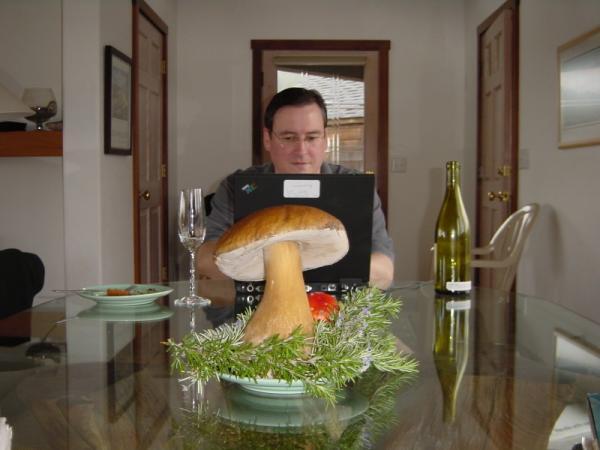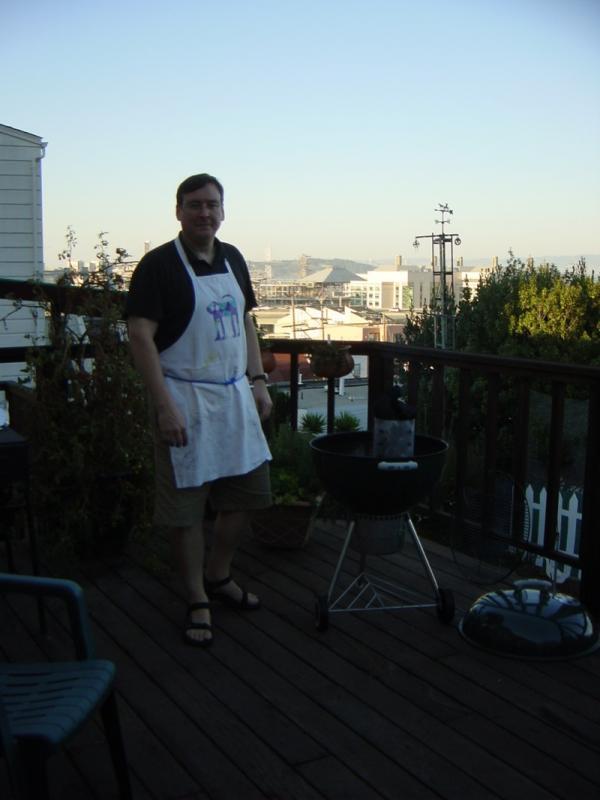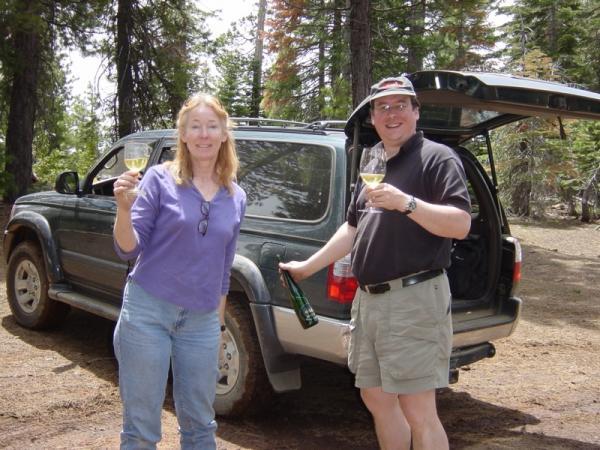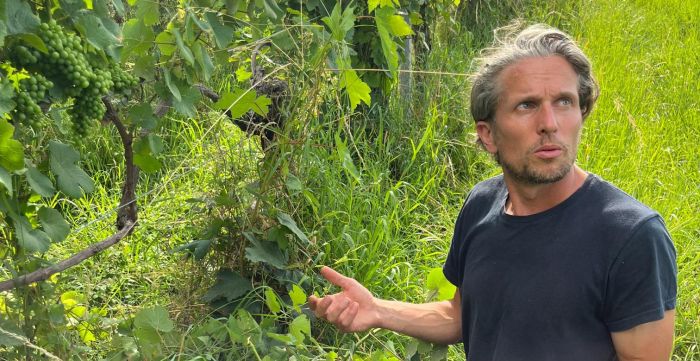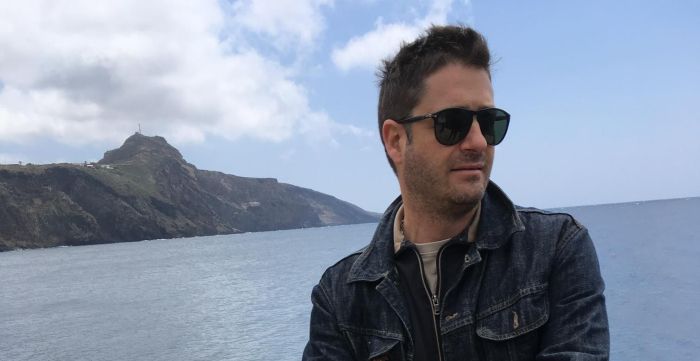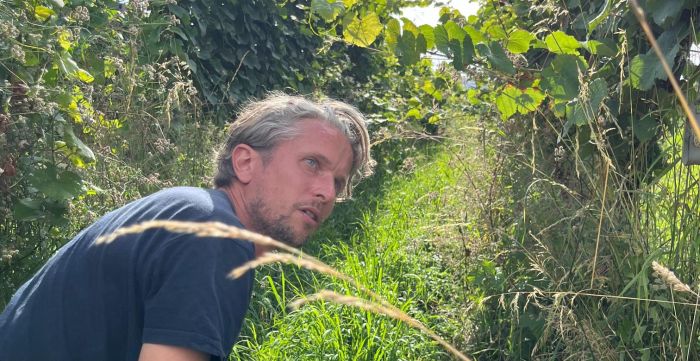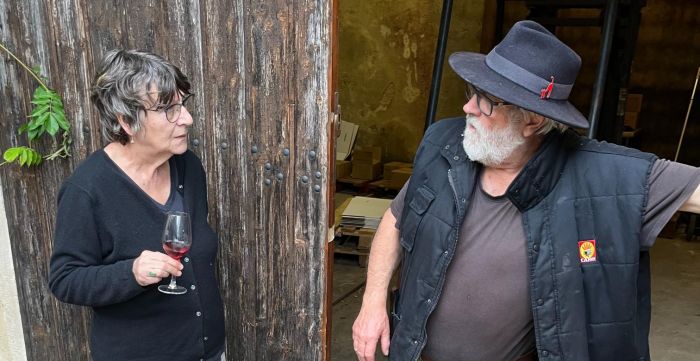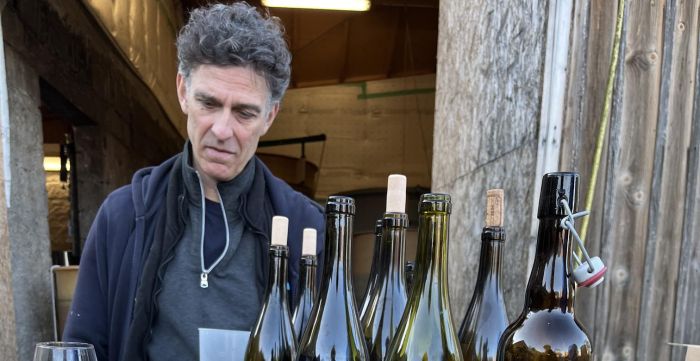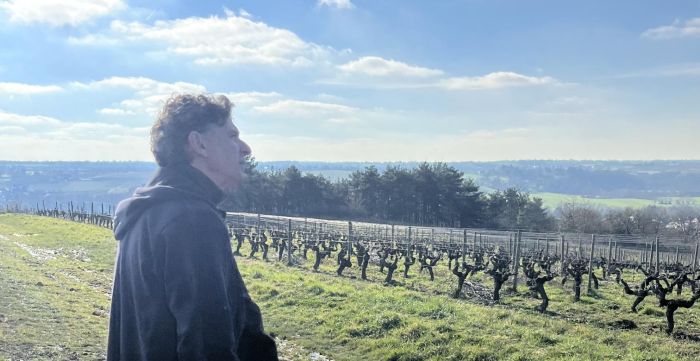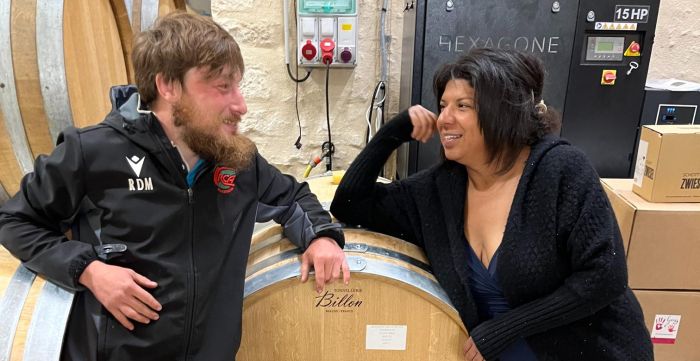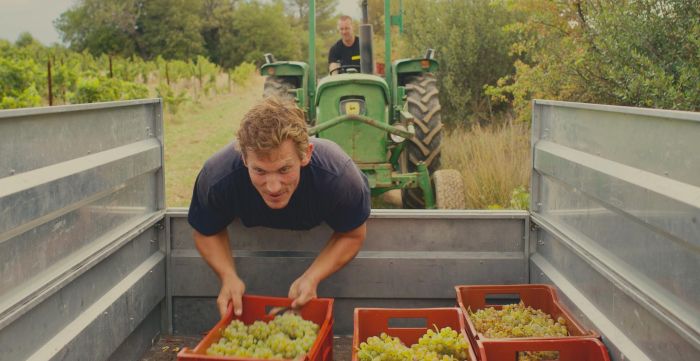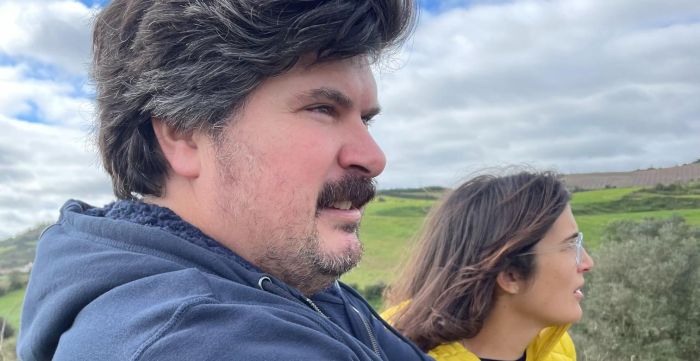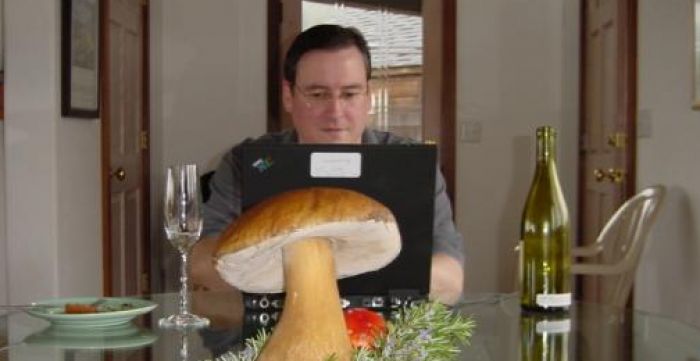A Deeper Dive Into Yannick's Work Philosophies
A deeper dive into Yannick's work philosophies
Read more…
interview
<p><em><strong>On working with oxygen in the cellar:</strong></em></p>
<p>Before starting to vinify Riesling by direct-pressing it, I took the time to taste many wines made on this type of terroir: that is to say hard soils such as granite, schist or gneiss. These geological formations, created millions of years ago by extremely high temperatures, were literally "cooked": the minerals and soils hardened at more than 1,000° at the bottom of the oceans, in the center of the Earth or during volcanic episodes. What happens at such temperatures? Minerals of the same family group together: mica with mica, feldspar with feldspar.</p>
<p>Let's imagine clay, a particularly chaotic soil found only on the Earth's surface. Why this exclusive location? Simply because clay represents minerals and organic matter decomposed by water and air, elements belonging to the living realm. It is teeming with bacteria and yeasts that can only decompose on the surface, precisely where water and air are found. It's comparable to our intestine: a living environment, fermenting and constantly decomposing.</p>
<p>Now let's take this clay and place it under pressure and heat equivalent to 1,000 tons per cm² and 1,000° temperatures like at the center of the Earth. What happens? It hardens to become schist. With even more pressure and heat, it evolves into mica-schist, and then finally into transparent garnet, just as limestone becomes marble. It then becomes hydrophobic and devoid of oxygen.</p>
<p>What should we understand from all of this? These hard soil compositions are associated with the non-living, such as space or the Earth's center and surface. They belong to the cosmos, like a solar summer in a cloudless July, under high pressure, diffusing its heat.</p>
<p>The opposite of this non-living world constitutes our habitat: the intestine, the planetary surface between 20 km above and 20 km below, where oxygen and water coexist. The terrestrial, the living, the water, the low pressure...</p>
<p>This is why vines were historically planted on hillsides: there is clay for the link to the living (growth, fermentation) and hard soil for the non-living (flower, fruit, aromatic, tannins, bitterness).</p>
<p>Is oxidation linked to oxygen and therefore to living things, to decomposition? A wine grown on clay oxidizes much more easily than a wine from hard soils, ones without affinities to oxygen. Moreover, a wine with volatile acidity, a "hardening" in a non-living process, can neither oxidize nor age well.</p>
<p>In the past, when fermentations progressed more favorably thanks to less sunny climatic conditions – with grapes tending towards noble gray rot rather than bacterial acid rot – these wines, having grown in a living environment, continued to evolve in the bottle, with oxygen beneficially continuing this evolution.</p>
<p>Another observation: even vines growing in clay soils tend towards horizontality by thickening, unlike vines planted in hard soils such as schist, which elongate more.</p>
<p>With climate change, wines are becoming too influenced by pressure and heat, adopting solar notes and exuberant aromatics, as opposed to humic and fungal characteristics.</p>
<p>So, quite simply, I practice oxidative aging in foudre for my white wines from hard soils: to extract them from their verticality due to their hydrophobic and oxygen-deprived soils, in order to open them up to life and fluidity.</p>
<p>The soil guides winemaking as much as climate: everything is linked. A rainy year will evoke clay through its connection to life, while an overly sunny year will evoke hard soil. The idea is to bring the opposite to create balance. In Burgundy, soils composed of clay and porous limestone require avoiding excess oxygen due to the risk of oxidation. In the Jura, the blue marls are reductive, hydrophobic, and devoid of oxygen: oxidative aging is therefore used.</p>
<p>Grape juice, undergoing organic fermentation, transcribes the climate and the soil, thus becoming their revealer. As you know: the page is the soil, the grape the ink.</p>
<p><em><strong>On his affinity for volatile acidity:</strong></em></p>
<p>Volatile acidity brings umami and is also a way for me to break out of the ever-perfectionist straitjacket imposed by the appellation and the social pressure of those who uphold good taste. Breaking out of it to bring charm, imagination and poetry, to thumb my nose at the wine that fits into the boxes.</p>
<p>Specifically with Gewürztraminer, I like to induce acetate during the maceration by filling the tank to the brim: the yeasts will react with the bacteria and the oxygen to develop the acetate, which will give a candy-like quality and a sensation of sweetness to the wine, characteristics that are perfectly suited to Gewürztraminer.</p>
<p><em><strong>On pigeages: </strong></em></p>
<p>The idea behind pigeage is to feed the dominant indigenous yeasts to develop day by day and overpower the bacteria. Temperatures rise naturally because of the energy created, and then I open the vat to release the excess carbonic aromas. Also, the rising temperature helps eliminate the tannin-protein association through flocculation.</p>
<p><em><strong>On blending vintages together:</strong></em></p>
<p>Every wine is defined by terrestrial and the cosmos. I define terrestrial as what the wine gets from the vine and the soil: minerality, acidity, drinkability. In constrast, I define the cosmos as qualities linked to solar energy: aromatics, color, depth, structure.</p>
<p>Vinegar is based on bacteria and botrytis on fungus. In such, vinegar implies death and fungus implies life: decomposition in contrast to fermentation. 20 years ago, there was no vinegar in the vines, only botrytis, and this is entirely linked to climate change. Pinot Noir, which I esteem is no longer adapted to Alsace and Burgundy, continues to turn to vinegar in the vines in solar years. </p>
<p>I've increasingly started to blend vintages a lot in order to regain the balance that we've lost with climate change. What I mean is that years that combine a rainy spring with a sunny summer are becoming rarer. So I've decided to blend a rainy year with a warm year to restore the lost balance of a season that was normal. This way, we find the depth, tannins, color, and aromas of a warm year, combined with the fluidity and minerality of a rainy year.</p>
<p><em><strong>On his one of a kind pruning technique:</strong></em></p>
<p>This pruning method comes to us from Marceau Bourdarias, a specialist in plant physiology. Many of his concepts are inspired by the work of Olivier Husson, an expert in oxidation and reduction. The fundamental idea is based on this principle: when a plant suffers a pathogen attack, it oxidizes and loses its electrons, causing a decrease in reduction and, consequently, increased oxidation. This phenomenon is observed during the treatment season with diseases such as downy mildew or powdery mildew, but also during the winter period with esca, which penetrates the plant.</p>
<p>This is why my interventions aim to reduce this oxidation by strengthening the reduction processes. For my treatments, I use bacterial fermentations enriched with zeolite that feed the leaf and plant with electrons, thus maintaining their reduction. This approach is similar to the probiotics that a patient absorbs to counteract the oxidation induced by cancer and chemotherapy. The longest-lived populations consume large quantities of fermented foods teeming with life, unlike pasteurized products which, having undergone pressure and heat, are devoid of vitality.</p>
<p>Applied to pruning, the principle remains the same. The vine can only heal on the cane of a one-year-old wood: in reality, it simply covers the wound using its tannins. On older pruned wood – two, three, or four years old – it is unable to close the wound, which remains gaping and vulnerable to attack. I therefore manage to constantly maintain the same pruning line and only cut on the wood from the previous year. This technique causes the plant to gradually lengthen and compartmentalize its reserves, giving the vine a sensation of growth, like a liana trying to reach the canopy.</p>
A Remembrance of Sebastiano De Bartoli
A Remembrance of Sebastiano De Bartoli
Read more…
article
<p>After a long and valiant battle against cancer, Sebastiano De Bartoli passed last<br />
week…I’ve a heavy heart. The middle child and second son of the real-life legend Marco de Bartoli, Sebio is the reason we’ve worked with the fascinating and quite often sensational wines of the two estates – the historic Marsala cellar in Contrade Samperi and the Arabic-influenced Bukkuram farm on the island of Pantelleria. While both cellars were founded by his visionary father, Sebastiano along with his brother and sister, Renato and Giuseppina, brought the wineries into the new century with equal commitment to quality and tradition.</p>
<p>A maverick about preserving the tradition of pre-British Marsala wine -- unfortified with perpetual aging in barrels at a naturally high alcohol level – Marco ran up against the law and put fear in the heart of the large and lucrative commercial Marsala producers. As a result, the fraud authorities unjustly shut down the winery for a few years. Finally, he was found to have done nothing wrong, but the closure had taken its toll and the moment arose when for his kids to move forward and for him to step back. </p>
<p>Sebastiano became responsible for the farm on Pantelleria of 6HA (dividing his time between Marsala and Pantelleria) and Renato and Gipi were in Marsala – Renato perfecting the classic method sparkling wine and fighting the authorities to finally accept their Vecchio Samperi as a legitimate regional wine with long history (though they could not label it as Marsala) and Gipi in charge of affairs. But Sebastiano also lobbied his siblings to create a new line of wines that also represented a regional tradition in both Marsala and Pantelleria – skin-contact dry white wines from Grillo (Marsala) and Zibibbo (Pantelleria) – these are the Integer line of wines.</p>
<p>Sebastiano realized that they were heading in a direction that required a change to their distribution – finding partners that were focused on and understood the importance of their work and legacy. A few of the growers with whom we were working at the time also enjoyed a deep friendship and mutual respect with Marco, and, I‘m guessing here, our name came up. Sebio contacted me and we met up at either one of the trade shows like Vini di Vignaioli or maybe it was Vinitaly itself or maybe both. That was the beginning of a rapport that I’ve always treasured and have missed terribly in recent years. It was somewhere around 2010, I think, that I showed up in Marsala and (am forever grateful) to have had some time with Marco himself<br />
and the rest of the family….in the following years Sebastiano and I spent quite a bit of time together.</p>
<p>Sebastiano was not only a vignaiolo, a thinker, a sculptor, a painter, an innovator, a bit of an infamous lothario, a collector of gorgeous vintage Italian cars, oh, and, damn, a really good cook! But also, finally, a son, brother, husband, father. And like his dad a fiercely proud, enthusiastic Sicilian. One time, for instance, he made our group stop for, what he considered, the best cannoli in a dusty, very hot and tiny town about 30 minutes before Marsala on the route from Palermo. He wasn’t wrong. Sebastiano’s many visits to the US whether with our growers on tour, with his sister on her first voyage to the US or in the company of then-fiancé, now-wife, Eleonora or as a part of the team of young “turks” - Arianna, Saša and Luca Roagna - are cherished memories for all of us.</p>
<p>I send all my best condolences to the entire De Bartoli family and especially to Elenora and the children.</p>
<p>Ci brindiamo tutti quanti con tanto affetto e tutto del mio cuore nostro carissimo<br />
collego nella battaglia per i vini di tradizione e anima. Addio, caro Sebastiano.</p>
Yannick Meckert Producer Profile
Yannick Meckert Producer Profile
Read more…
producer profile
<p>Sometimes you just feel it: energy, connection, a point of view, singularity. From our very first exchange with Yannick Meckert, the way he communicated -open, thoughtful, detailed, attentive, philosophical- emitted a special energy. The rapport was immediate, first through emails, then a handful of hour-plus phone calls and finally a visit in the summer of 2024. By the end of that tour of the cellar and vines, it was clear that we would work together. I mean, how often do you spend over half an hour discussing the memetic illusion of expressing individuality through the consumption of instagram-approved agricultural products in urban centers? Or dissecting the philosophical merit of intentionally incorporating volatile acidity into your wines to create an “umami bomb”? Or, our personal favorite, spending the entire visit debating potential names for Yannick’s soon to be born daughter (it needed to be Alsatian, Denyse Louis proposed Liselle, which stuck. Liselle Meckert was born in November 2024.) What a trip!</p>
<p>Yannick Meckert was born in a viticultural Alsatian family. An avid consumer of philosophy, his scholarly ambitions were initially stifled by the usual pressures and expectations of the countryside: helping out at the farm, taking over the estate… Reluctant, he eventually agreed to enroll in viticultural/enology school instead of pursuing a degree in philosophy. Yet within six months of returning to work with his father, he’d become totally disenfranchised with the chemical, artificial work in the vines. Unable to find meaning in this life and heritage, Meckert chose to pack his bag and leave Alsace.</p>
<p>Setting out to create his own meaning and understanding of this <em>métier</em>, Meckert embarked in what would become a years-long pilgrimage, learning the ins and outs of every aspect of the wine industry, including restaurant and wine bar stints in Copenhagen and Tokyo. Of course the vines/wines were always calling, leading to many apprenticeships including Pax Cellars in California, Le Coste in Lazio, Phillipe Pacalet in Burgundy, Bruno Schueller and Patrick Meyer in Alsace amongst many others. From these experiences -Yannick scrupulously references specific examples that have directly influenced his viticultural and vinification philosophy- he produced his first independent vintage in 2019. Well sort of, because he was so unhappy with the wines that he decided to sell the finished bottles to a négociant who rebranded them with her own label. 2020, on the other hand, was magnificent!</p>
<p>Knowing that rejoining the family estate was not possible, Yannick sourced three hectares of vines to rent as well as an unused cellar in the village of Rosheim. Working these vines and buying the equivalent of a hectare’s worth of fruit through the 2024 vintage, he’s produced various expressions of Riesling, Auxerrois, Gewürztraminer, Pinot Gris and Pinot Noir. In 2024, Meckert purchased 2.5 hectares of Riesling and Pinot Noir on steep coteaux he considers amongst the very best in Alsace. Two wines were produced from this land that same year, to be released “at some point”. From the 2025 vintage onwards, Meckert plans to forego his rented vines and make only two wines, a Riesling and a Pinot, for the remainder of his career.</p>
<p>Before going any further, it’s important to note that Meckert comes from the “sentient terroir” school, entailing that man and his ideas are as much part of a wine’s composition as the soil, climate and vintage conditions (it’s also important to note that I just made that term up.) Keep this in mind because we are about to list a lot of left-field techniques you’ve likely never heard of anyone else practicing.</p>
<p>Let’s start with cellar work, which is detail-oriented and intentional. From the beginning, Yannick made the choice to not use stainless steel as they trap electrons. Instead, he uses fiberglass tanks of various sizes -some tiny, some huge- for macerations and fermentations. Along with a few tronconic vats, Burgundian barrels, barriques and sandstone amphoras, he principally uses old, second-hand foudres purchased from Bruno Schueller and Claus Preisinger -some over 100 years old- for his elevages.</p>
<p>For wines coming from schist soils, Yannick believes in “hyper-oxygenation”, letting his old foudres exposed to oxygen for three months at a time. In some cases, he will not perform ouillages either (<strong>ed note: </strong>for more insight on this technique and many of those described below, we highly recommend reading our separate article where Yannick elaborates on his techniques in great detail.)</p>
<p>In balancing the terrestrial -what he defines as the vine and the earth’s production of minerality and acidity- to the cosmos: solar energy that will bring fruit, flower and aromatics, blending vintages has increasingly become a core tenet of Yannick’s philosophy. By blending colder, wet vintages with hotter ones, he hopes to "regain the balance that we've lost with climate change”.</p>
<p>Likely the most polarizing tenet of Meckert’s cellar philosophy is the inclusion of acetic juices to intentionally bring volatile acidity into many of his wines. Dubbed his “umami bomb” or “imperfection as salt to beauty”, this can mean setting 5% the juices aside and blending into a larger vat when it begins to turn. Or adding unfermented juice during a partial fermentation. Or even letting the whole cuvée intentionally become volatile by overfilling it before racking it to old foudre. These techniques are applied by instinct and only in certain cases, except with Gewürztraminer where it is always used as it helps “tame the opulence” of the ultra-aromatic, often sweet wines resulting from this grape.</p>
<p>White grapes are directly pressed or macerated depending on the vintage conditions. For reds, Meckert is partial to short “Jules Chauvet” whole-cluster macerations. Pigeages, usually one a day for whites and two a day for reds during a six to eight day period, are also the norm. Again, all of this is done by instinct and changes year to year, resulting in cuvées that vary in their grape composition, vinification, label art and cuvée name each vintage.</p>
<p>In the vines, Meckert’s confluence of influences (confluinfluence?) is equally singular. The soil work, or lack thereof, is two-fold. On clay soils, <em>“everything grows”</em>, since these terroirs are <em>“related to life”</em>. Looking like a mystical forest, these parcels are never plowed and the grass never cut (nor are the vines, which grow high and rambunctious). But on stone soils such as schist, Yannick applies cover-crops in every row in order to “bring life where there is none”.</p>
<p>In regards to vineyard maintenance, Yannick does not replace dead vines but rather extends thriving ones by only pruning one-year old woods in the same direction.</p>
<p><em>“Vines are lianas. That’s what they want to be. Most viticulture prevents vines from being what they naturally are.”</em></p>
<p>As Denyse Louis put it during our first visit, it’s a type of elevated marcottage, resulting in one very long vine producing fruit. According to Yannick, it also forces the roots of the vine to go deeper to feed themselves, leading to increased minerality. In our decades of visiting vineyards, this is the first time we’ve seen this type of system implemented.</p>
<p>For treatments, Meckert has impressively managed to not use copper or sulfur at all in the vines certain vintages but will treat if he has to. Rather than sticking purely to the traditional copper and sulfur, he prefers using salt water and molasses to combat odium, and also likes to spray clay zeolites to bring electrons and “reduction” to the vines. No fertilizers are ever applied as the vines are very vigorous.</p>
<p>Finally, we must discuss the choices in packaging. With often-poetic cuvée names related to human emotions or, in a couple cases, references to books and films that have moved him over the years, the labels vary from austere to pop-art pastiche, always with a self-referential sense of humor and sense of permeating mischief. In an act of rebellion, Meckert forgoes using the traditional slim and long Alsatian bottle shape in favor of Burgundian bottles and intentionally declassifies himself from the Alsace appellation, selling his entire production as Vin de France. While this may not feel particularly radical anymore in certain parts of France, in the context of Alsace it is all but unheard of: a true critique of the limits imposed by such a storied but inflexible viticultural region.</p>
<p>Other, funner examples:</p>
<p>-The estate’s logo, itself an ode to the pop art of Andy Warhol, is a reinterpretation of the Gauloises cigarettes logo with a grape bunch instead of a Gaul helmet.</p>
<p>-The “label” of his first Riesling in 2020 was printed on scotch tape so that fancy restaurants would feel uncomfortable serving it.</p>
<p>-Naming a wine “A L’Ombre des Jeunes Vignes en Fleurs”, knowing it would annoy sommeliers typing out their lists and surely look awkward on the page.</p>
<p>-A recent run of cryptic labels looking exactly like Gallimard book covers (one of France’s biggest publishing houses): read me like a book!</p>
<p>-<em>“With French law recently adopting a new restriction forcing producers to add a QR code listing all ingredients on the label, I have decided to include another QR code next to it connecting to my website with a reference list of my anarchist ideas inspired by thoughtful researchers such as Proudhon or Bruno Latour. It's sort of a response to the state's obligations.”</em></p>
<p>If this profile seems long-winded, it’s because we are very excited to be representing this estate. Yannick Meckert is the type of vigneron you only meet a handful of times in our line of work: one who reminds us, despite all of the hype and glam and bullshit that has occurred in the rise of natural wine over the last decade, that what we do in this little world is still very much alive and worth fighting for. Like Gianfranco Manca of Panevino, Tom Lubbe of Matassa or the late Julie Balagny, Meckert’s work challenges and questions conventions, ultimately seeking the answers necessary to forge a singular, deeply personal path.</p>
<p>Philosophy as wine. </p>
<p>And look, we understand that may not be for everybody. But if the following text adorning each back-label even remotely piques your interests, we just might think you’ll dig it:</p>
<p><em>“Imperfection is salt to beauty. I try to capture the energy, the elevation, the will of a place. To capture its essence for easy reading, to approach the yin and the yang, the terrestrial and the cosmic, the soul of a wine. To describe this wine through reason would extinguish it instead of feeling and drawing from its electrons.” </em></p>
Domaine Chamonard Producer Profile
Domaine Chamonard Producer Profile
Read more…
producer profile
<p>Domaine Chamonard is a multi-generation family estate run, somewhat unintuitively, by the Chanudet family. At the helm for over 50 years, Jean-Claude "Le Chat" Chanudet has humbly been making "Jules Chauvet" style, semi-carbonically fermented Beaujolais for decades. In fact, Beaujolais lover and good friend Eric Texier considers Chanudet, who is meticulous in his lab analyses of his wines, the closest of anyone to work the way Chauvet intended. </p>
<p>Retired on paper but still a daily presence in the vines and cellar, Jean-Claude recently passed on the estate to his daughter Jeanne, and together they work a total of 5.5 hectares. The vast majority is in the Morgon cru, where they farm seven parcels spread over three major sectors: Grands Cras, Le Colombien and Chateau Gaillard. The rest of the vines are in the Fleurie lieu-dit La Madone: a very steep hill and amongst the most famous in the cru. </p>
<p>While each Morgon parcel is vinified individually, the Chanudet intentionally choose to make a single Morgon each vintage, creating a complex blend of their terroirs. Firm believers in selling this cuvée when it's drinking at its best, they release the wines non-chronologically. For example, they have just recently sold out of the 2021 and just now commercialising the 2020. They also intentionally hold back significant quantities to intentionally age and release them many years later, hence our opportunity to offer you the 2015 vintage. The Fleurie, on the other hand, is bottled as La Madone and, due to the style and limited amounts produced, released chronologically.</p>
Jean-Christophe Garnier Producer Profile
Jean-Christophe Garnier Producer Profile
Read more…
producer profile
<p>For years now, Jean-Christophe Garnier’s complex <glossary term="Chenin Blanc" title="281">Chenin Blancs</glossary> and easy drinking reds are wines we have loved and admired from afar. From first discovering them at The Ten Bells in the late aughts (the cash only days!), ordering bottles whenever in Paris or the obligatory <glossary term="Magnum" title="617">magnum</glossary> following post-<span class="zalup"><span><glossary term="Dive Bouteille" title="395">Dive Bouteille </glossary></span></span>romps at le Cercle Rouge in <span class="zalup"><span><glossary term="Angers" title="104">Angers</glossary><span>,</span></span></span> Garnier’s work is something we’ve long admired as fans. And based on the immediate excitement of our customers bringing the wines back to the US market after a six year hiatus, it would seem many of you feel the same way!</p>
<p>With no family ties to <glossary term="Viticulture" title="1103">viticulture</glossary> or winemaking, Garnier found his passion for wine as a <glossary term="Sommelier" title="969">sommelier</glossary> in his home region of <span class="zalup"><span><glossary term="Brittany" title="197">Brittany</glossary><span>.</span></span></span> In the late 1990’s, he took a year off to go study <glossary term="Viticulture" title="1103">viticulture</glossary> in hopes to deepen his knowledge before opening a wine bar with a friend. Due to its proximity to <span class="zalup"><span><glossary term="Brittany" title="197">Brittany</glossary><span>,</span></span></span> he enrolled in a school close to the <glossary term="Viticulture" title="1103">viticultural</glossary> region of <span class="zalup"><span><glossary term="Anjou" title="105">Anjou</glossary><span>,</span></span></span> where he was placed in an apprenticeship working with Mark Angeli of the legendary Ferme de la Sansonièrre. Typical of Angeli, Mark immediately encouraged JC to start a new life by creating his own <span class="zalup"><span><glossary term="Estate" title="427">estate</glossary><span>.</span></span></span> After completing his curriculum, Garnier went back to restaurants for a couple of years but ultimately returned to <glossary term="Anjou" title="105">Anjou</glossary> after Angeli found him a couple of <glossary term="Hectare" title="523">hectares</glossary> to start his own <glossary term="Estate" title="427">estate</glossary> in 2002.</p>
<p>Far from the hotbed of forward-thinking producers that currently populate the area, <glossary term="Anjou" title="105">Anjou</glossary> was at the time a struggling region known mostly for its sweet <glossary term="Bonnezeaux" title="177">Bonnezeaux</glossary> and <glossary term="Coteaux-du-Layon" title="349">Coteaux du Layon</glossary> <glossary term="Appellation" title="113">appellation</glossary> wines, with generic <glossary term="Anjou" title="105">Anjou</glossary> whites mostly produced as cloyingly sweet, <glossary term="Filtration" title="447">sterile-filtered</glossary> copycats of the aforementioned <glossary term="AOC" title="108">AOC</glossary>’s. The wines made with red grapes weren’t faring so well either: <span class="zalup"><span><glossary term="Tannin" title="1010">tannic</glossary><span>,</span></span></span> rustic <glossary term="Grolleau" title="513">Grolleau</glossary> and <glossary term="Cabernet Franc" title="216">Cabernet Franc</glossary>/<glossary term="Cabernet Sauvignon" title="217">Cabernet Sauvignon</glossary> <glossary term="Blend" title="168">blends</glossary> or Rosé d'Anjou, another cloyingly sweet, <glossary term="Filtration" title="447">sterile-filtered</glossary> beverage that had become increasingly difficult to sell by the turn of the millennium.</p>
<p>Garnier, along with a small group of now legendary trailblazers- Mark Angeli, Richard Leroy, Patrick Baudoin and Agnès and René Mosse to name a few- took advantage of the region’s identity crisis, gaining access to cheap, readily available land from the mid 1990’s through the mid 2000’s. Decades ahead of their time, these outsiders saw the potential to break away from sweet wine production, particularly by producing dry or off-dry whites highlighting the incredibly varied types of <glossary term="Schist" title="933">schist</glossary> <span class="zalup"><span><glossary term="Terroir" title="1026">terroirs</glossary><span>,</span></span></span> <span class="zalup"><span><glossary term="Microclimate" title="656">micro-climates</glossary><span>,</span></span></span> <glossary term="Exposition" title="430">expositions</glossary> and <glossary term="Elevation" title="419">elevations</glossary> the region has to offer.</p>
<p>Starting with 2.3 <glossary term="Hectare" title="523">hectares</glossary> in 2002, from the beginning Garnier’s production has consisted of <glossary term="Single Vineyard Bottling" title="959">single vineyard expressions</glossary> of <span class="zalup"><span><glossary term="Chenin Blanc" title="281">Chenin Blanc</glossary><span>:</span></span></span> starting with les Dreuillés (no longer in production), over the years this has come to include Bézigon, la Roche, Rouchefert and the recently acquired Les Justices and 13 Vents, with each wine named after their respective <span class="zalup"><span><glossary term="Lieu-Dit" title="594">lieu-dit</glossary><span>.</span></span></span> The <glossary term="Chenin Blanc" title="281">Chenin</glossary> grapes are <glossary term="Direct Press" title="392">direct-pressed</glossary> and, while <glossary term="Vinification" title="1104">vinified</glossary> and <glossary term="Aging" title="74">aged</glossary> in various vessels, the intent is always to express <glossary term="Terroir" title="1026">terroir</glossary> through wines approachable in youth but ultimately meant to <glossary term="Cellaring" title="255">cellar</glossary> and <span class="zalup"><span><glossary term="Aging" title="74">age</glossary><span>.</span></span></span></p>
<p>Reds came only in 2010, with <span class="zalup"><span><glossary term="Pineau d'Aunis" title="799">Pineau d’Aunis</glossary><span>,</span></span></span> <span class="zalup"><span><glossary term="Grolleau" title="513">Grolleau</glossary><span>,</span></span></span> <span class="zalup"><span><glossary term="Gamay" title="478">Gamay</glossary><span>,</span></span></span> <glossary term="Cabernet Franc" title="216">Cabernet Franc</glossary> and <glossary term="Cabernet Sauvignon" title="217">Cabernet Sauvignon</glossary> rounding out the lineup. In contrast to the more serious nature of the whites, JC opts for short, <glossary term="Infusion" title="1378">infusion</glossary> style <glossary term="Whole-Cluster" title="1124">whole-cluster</glossary> <glossary term="Maceration" title="610">macerations</glossary> for his reds, resulting in a more <glossary term="Vin de Soif" title="1094">vin-de-soif</glossary> style. Most of his reds are <glossary term="Bottling" title="185">bottled</glossary> very early -some as early as November of the same year- and meant to drink relatively young. The one exception is "Les Tailles", a <glossary term="Lieu-Dit" title="594">lieu-dit</glossary> planted in <glossary term="Cabernet Franc" title="216">Cabernet Franc</glossary> that sees a 12 day, <glossary term="Whole-Cluster" title="1124">whole-cluster</glossary> <glossary term="Infusion" title="1378">infusion</glossary> <glossary term="Maceration" title="610">maceration</glossary> then <glossary term="Fermentation" title="441">ferments</glossary> and <glossary term="Aging" title="74">ages</glossary> 12 months in <glossary term="Barrel" title="142">barrel</glossary> before release.</p>
<p>The estate has been <glossary term="Organic Certification" title="260">certified</glossary> <glossary term="Organic" title="746">organic</glossary> since its inception. Garnier currently farms 10 <glossary term="Hectare" title="523">hectares</glossary> of vines, though a significant amount of that land consists of new plantations, of which only some of the <glossary term="Parcel" title="760">parcels</glossary> are just starting to produce fruit. Four distinct and seperate sectors are farmed, three surrounding the village of <glossary term="Saint-Lambert-du-Lattay" title="983">Saint-Lambert-du-Lattay</glossary> and one in the village of Saint-Aubin-de-Luigné. Creating competition for the vines so they can sink their roots further into the <span class="zalup"><span><glossary term="Mother Rock" title="690">mother rock</glossary><span>,</span></span></span> he likes to plant at a much higher density than what is tradtional in the region, 6500 to 7000 vines per hectare versus the typical 5000 to 5500. </p>
<p>In addition to his own production, for the last few years Garnier has purchased the equivalent of two <glossary term="Hectare" title="523">hectares</glossary> of <glossary term="Organic" title="746">organically</glossary> farmed fruit from a nearby <glossary term="Vigneron/Vignaiolo" title="1089">vigneron</glossary> with soils quasi-indentical to those he farms. Including the single <glossary term="Négociant" title="729">négociant</glossary> <glossary term="Cuvée" title="363">cuvée</glossary> "Les Nouettes", production is split roughly 50/50 between white and red wines.</p>
<p>In the <span class="zalup"><span><glossary term="Cellar" title="254">cellar</glossary><span>,</span></span></span> Garnier began omitting <glossary term="Sulfites" title="993">S02</glossary> from his wines in the 2006 <span class="zalup"><span><glossary term="Vintage" title="1109">vintage</glossary><span>,</span></span></span> the same year he intentionally <glossary term="Declassification" title="383">declassified</glossary> his wines from <glossary term="Anjou" title="105">Anjou</glossary> to <glossary term="Table Wine" title="1006">Vin de Table</glossary> (a now common occurence that was all but unheard of at the time). Many <glossary term="Vintage" title="1109">vintages</glossary> were <glossary term="Vinification" title="1104">vinified</glossary> entirely without added <glossary term="Sulfites" title="993">sulfites</glossary> between 2006 and 2016, though in two vintages Garnier felt obliged to use very small amounts at <span class="zalup"><span><glossary term="Pressing" title="827">press</glossary><span>.</span></span></span> However, with time and experience he has come to believe those <glossary term="Sulfites" title="993">sulfur</glossary> additions did nothing to alter the identity or course of those wines, leading him to stick to a stricly zero <glossary term="Sulfites" title="993">S02</glossary> policy from the the 2016 <glossary term="Vintage" title="1109">vintage</glossary> onwards. From our experience, this decision comes less from dogma and more from JC's cerebral, attentive nature and conviction that <glossary term="Vinification" title="1104">vinifying</glossary> this way best expresses his <span class="zalup"><span><glossary term="Terroir" title="1026">terroirs</glossary><span>.</span></span></span></p>
<p>For more in depth information, please read our interview with Jean-Christophe.</p>
Jean-Christophe Garnier Interview
Jean-Christophe Garnier Interview
Read more…
interview
<p><em><strong>This interview with Jean-Christophe Garnier took place over Zoom in September 2024.</strong></em></p>
<p><strong>What were you doing before becoming a vigneron?</strong></p>
<p>I’m from <glossary term="Brittany" title="197">Brittany</glossary> and first got into wine working as a <span class="zalup"><span><glossary term="Sommelier" title="969">sommelier</glossary><span>.</span></span></span> It was my career for about a decade. I eventually decided to open a wine bar with a friend, but before doing so I told him I wanted to take a year off to learn more about working in the vines. All of my wine education up until that point had come from books, so I wanted to experience things first-hand.</p>
<p>In 1998, I enrolled in a <glossary term="Viticulture" title="1103">viticultural</glossary> school not too far from <glossary term="Anjou" title="105">Anjou</glossary> and was lucky enough to find myself apprenticing with Mark Angeli at Ferme de la Sansonièrre. From the start, he was very supportive and insistant that I start my own <glossary term="Estate" title="427">estate</glossary> in <span class="zalup"><span><glossary term="Anjou" title="105">Anjou</glossary><span>.</span></span></span> After finishing my program, I went back to restaurants for a bit but ultimately decided to come back here to start making wine myself. That was in 2002.</p>
<p>Mark helped me find 2.5 <glossary term="Hectare" title="523">hectares</glossary> to launch my project. I then found a house in the village of <glossary term="Saint-Lambert-du-Lattay" title="983">Saint-Lambert-du-Lattay</glossary> for my family with an adjoining <glossary term="Cellar" title="254">cellar</glossary> for my wines. And from the strong <glossary term="Viticulture" title="1103">viticultural</glossary> community in the village, I was able to grow and develop the <glossary term="Estate" title="427">estate</glossary> to what it is today.</p>
<p><strong>Today, Anjou is arguably the most dynamic region in the Loire for newer producers just starting out. When you started it was a very different climate. What made you want to make wine in Anjou?</strong></p>
<p>First and foremost, <glossary term="Anjou" title="105">Anjou</glossary> is relatively close to <span class="zalup"><span><glossary term="Brittany" title="197">Brittany</glossary><span>!</span></span></span> And I’d been selling <glossary term="Anjou" title="105">Anjou</glossary> wines for quite a few years as a <span class="zalup"><span><glossary term="Sommelier" title="969">sommelier</glossary><span>.</span></span></span> There was also the strong support from Mark Angeli and what I suppose has become the first wave of forward-thinking <glossary term="Vigneron/Vignaiolo" title="1089">vignerons</glossary> from that time (Mosse, Leroy, Baudoin…) There were also lots of cheap vines to recuperate and room to build out <glossary term="Cellar" title="254">cellars</glossary> as well.</p>
<p>Working with <glossary term="Chenin Blanc" title="281">Chenin</glossary> -a grape with incredible versatility- was also an exciting prospect. <glossary term="Anjou" title="105">Anjou</glossary> is also a region where you have access to lots of different grapes, both red and white, as well as a fascinating variety of <span class="zalup"><span><glossary term="Terroir" title="1026">terroirs</glossary><span>.</span></span></span> And it’s close to <span class="zalup"><span><glossary term="Brittany" title="197">Brittany</glossary><span>!</span></span></span></p>
<p><strong>Did you make appellation wines in the beginning?</strong></p>
<p>Yes I did. At the time it was very rare for <glossary term="Vigneron/Vignaiolo" title="1089">vignerons</glossary> to intentionally <glossary term="Declassification" title="383">de-classify</glossary> their wines.</p>
<p><strong>And what were those early wines?</strong></p>
<p>I started with 2.3 <span class="zalup"><span><glossary term="Hectare" title="523">hectares</glossary><span>:</span></span></span> 80 <glossary term="Are" title="1208">ares</glossary> of <span class="zalup"><span><glossary term="Grolleau" title="513">Grolleau Gris</glossary><span>,</span></span></span> the rest in <span class="zalup"><span><glossary term="Chenin Blanc" title="281">Chenin Blanc</glossary><span>.</span></span></span> From the beginning I made dry whites, but in a different style than today. At the time everyone picked in “<glossary term="pouri plein" title="1493">pourri-plein</glossary>”, where we’d intentionally seek some over-maturity in the grapes. This picking style makes for very interesting <glossary term="Aromatic" title="120">aromatics</glossary> in a wine’s youth, but is also prone to heavy <glossary term="Oxidation" title="754">oxydation</glossary> and not very beneficial for <span class="zalup"><span><glossary term="Aging" title="74">aging</glossary><span>.</span></span></span></p>
<p>This technique for <glossary term="Chenin Blanc" title="281">Chenin Blanc</glossary> is a style really pioneered by Mark Angeli around 1995. 2005 was the nail in the coffin for picking this way, as the years were getting violently solar and it was impossible to make stable wine with slightly <glossary term="Botrytis/Noble Rot" title="181">botrytised</glossary> grapes without using <span class="zalup"><span><glossary term="Sulfites" title="993">sulfites</glossary><span>.</span></span></span></p>
<p>I’ve never understood why people feel the need to systematically add <glossary term="Sulfites" title="993">sulfur</glossary> to wine, so I started picking at optimal ripeness instead. Today, I’d even posit I look to pick at a slight under-maturity as to keep <span class="zalup"><span><glossary term="Acidity" title="71">acidity</glossary><span>.</span></span></span> But recently I’ve decided I want to go back to a slightly riper style. It means a bit more alcohol, but you get more complexity. I suppose it’s being in the middle of both extremes I’ve worked with in the past.</p>
<p><strong>You just brought up sulfites. Where does your conviction to not use S02 come from?</strong></p>
<p>As I mentioned earlier, all of my wine knowledge originally came from books. It was all about regions, grapes, <span class="zalup"><span><glossary term="Terroir" title="1026">terroirs</glossary><span>,</span></span></span> etc… I had zero notions on how to actually make wine until I started doing it myself. <glossary term="Sulfites" title="993">Sulfur</glossary> seemed to be this very important and necessary additive in winemaking, and I never really understood why. So very quickly, I started not using any.</p>
<p><strong>So you weren’t already a proselytizer of sans souffre wines while working as a sommelier?</strong></p>
<p>I sold some but there were very few readily available when I worked in restaurants. I recall some <glossary term="Côtes du Rhône" title="372">Côtes du Rhône</glossary> producers… For us the focus was more on <glossary term="Artisinal" title="122">artisanal</glossary> production from small, independent <span class="zalup"><span><glossary term="Vigneron/Vignaiolo" title="1089">vignerons</glossary><span>.</span></span></span></p>
<p><strong>What were your first “aha” moments with wine?</strong></p>
<p>I worked in <glossary term="Banyuls" title="135">Banyuls</glossary> and <glossary term="Collioure" title="319">Collioure</glossary> for a little while. While there, I met some of the local <glossary term="Vigneron/Vignaiolo" title="1089">vignerons</glossary> and also travelled in other parts of the <glossary term="Roussillon" title="880">Roussillon</glossary> and <span class="zalup"><span><glossary term="Languedoc" title="579">Languedoc</glossary><span>.</span></span></span> The <glossary term="Languedoc" title="579">Languedoc</glossary> in particular was going through a pretty exciting revolutionary period in the 1990’s. It was during that period that I really began to understand that good wine came from well farmed vines first and foremost. And this feeling was amplified when I did my apprenticeship in <span class="zalup"><span><glossary term="Anjou" title="105">Anjou</glossary><span>.</span></span></span> So yeah I’d say the <glossary term="Languedoc" title="579">Languedoc</glossary> and then the <span class="zalup"><span><glossary term="Loire Valley" title="602">Loire</glossary><span>.</span></span></span></p>
<p><strong>We touched on your beginnings in Anjou. Can you run us through the evolution of the estate over the years?</strong></p>
<p>I started in 2002 with 2.5 <span class="zalup"><span><glossary term="Hectare" title="523">hectares</glossary><span>.</span></span></span> In 2006 I got to 4.5 <glossary term="Hectare" title="523">hectares</glossary> which grew to five <glossary term="Hectare" title="523">hectares</glossary> by 2008. Then in 2010, I met a young man who was ready to invest in vines but didn’t want to start as full-time <glossary term="Vigneron/Vignaiolo" title="1089">vigneron</glossary> for a few years, so he needed someone to farm it in the interim. It was a <glossary term="Plot" title="1133">plot</glossary> of <span class="zalup"><span><glossary term="Gamay" title="478">Gamay</glossary><span>,</span></span></span> <glossary term="Pineau d'Aunis" title="799">Pineau d’Aunis</glossary> and <span class="zalup"><span><glossary term="Cabernet Franc" title="216">Cabernet Franc</glossary><span>.</span></span></span> Up until then, I basically made all white wine, with the <glossary term="Grolleau" title="513">Grolleau</glossary> destined for sweet <span class="zalup"><span><glossary term="Rosé/Rosato" title="871">rosé</glossary><span>.</span></span></span></p>
<p>Fellow <glossary term="Vigneron/Vignaiolo" title="1089">vignerons</glossary> told me that making red wine was a good opportunity; at the time in France, you’d sell three bottles of red for every bottle of white. But I still wasn’t convinced about making red wine: in fact it strayed from my original vision. In the end I rather enjoyed the experience, particularly with <glossary term="Gamay" title="478">Gamay</glossary> and <span class="zalup"><span><glossary term="Pineau d'Aunis" title="799">Pineau d’Aunis</glossary><span>.</span></span></span> I worked those vines from 2010 to 2020. The guy eventually decided not to become a <glossary term="Vigneron/Vignaiolo" title="1089">vigneron</glossary> and sold the vines to a young upstart for the 2021 <span class="zalup"><span><glossary term="Harvest" title="521">harvest</glossary><span>.</span></span></span></p>
<p>Since I knew I wasn’t going to be able to use those vines anymore and had built a reputation for my reds, I’d been actively seeking out new <glossary term="Parcel" title="760">parcels</glossary> to buy. I was able to find a good amount of land, some bare, some where I had to rip out and replant. I’ve planted or replanted mostly <glossary term="Pineau d'Aunis" title="799">Pineau d’Aunis,</glossary> but also more <glossary term="Chenin Blanc" title="281">Chenin</glossary> in certain sectors. In 2017, I jumped to nine <span class="zalup"><span><glossary term="Hectare" title="523">hectares</glossary><span>,</span></span></span> then in 2021 I bought another <glossary term="Hectare" title="523">hectare</glossary> and currently find myself farming 10. But much of surface consists of very young vines as I had to rip out and replant a lot. Some are just really starting to produce. It’s been a huge amount of work.</p>
<p><strong>Are you certified organic?</strong></p>
<p>I’ve been <glossary term="Organic Certification" title="260">certified</glossary> <glossary term="Organic" title="746">organic</glossary> since the very beginning.</p>
<p><strong>Can you give us a breakdown of the grapes you farm?</strong></p>
<p>I farm six <glossary term="Hectare" title="523">hectares</glossary> of <span class="zalup"><span><glossary term="Chenin Blanc" title="281">Chenin Blanc</glossary><span>,</span></span></span> with an additional <glossary term="Hectare" title="523">hectare</glossary> of <glossary term="Chenin Blanc" title="281">Chenin</glossary> planted in vines too young to produce. Then there is one <glossary term="Hectare" title="523">hectare</glossary> of <glossary term="Cabernet Franc" title="216">Cabernet Franc</glossary> with a tiny bit of <glossary term="Cabernet Sauvignon" title="217">Cabernet Sauvignon</glossary> (which I plan to rip out and replant at some point). There is 0.5 <glossary term="Hectare" title="523">hectares</glossary> of <span class="zalup"><span><glossary term="Grolleau" title="513">Grolleau Gris</glossary><span>, 0.5 <glossary term="Hectare" title="523">hectares</glossary></span></span></span><span class="zalup"><span> </span></span>of <span class="zalup"><span><glossary term="Savagnin" title="922">Savagnin</glossary><span>,</span></span></span> 1.5 <glossary term="Hectare" title="523">hectares</glossary> of <span class="zalup"><span><glossary term="Pineau d'Aunis" title="799">Pineau d’Aunis</glossary><span>.</span></span></span> <glossary term="Grolleau" title="513">Grolleau</glossary> and <glossary term="Gamay" title="478">Gamay</glossary> are about two <span class="zalup"><span><glossary term="Hectare" title="523">hectares</glossary><span>.</span></span></span></p>
<p>Then there is the <glossary term="Négociant" title="729">négociant</glossary> project which comes from a nearby two <glossary term="Hectare" title="523">hectares</glossary> of red grapes planted on <span class="zalup"><span><glossary term="Loam" title="1291">loamy</glossary><span>-</span></span></span><glossary term="Clay" title="301">clay</glossary> soils.</p>
<p><strong>What about the evolution of the cuvées? Was the focus always on single vineyard wines?</strong></p>
<p>I’ve been doing <glossary term="Single Vineyard Bottling" title="959">single-parcel</glossary> wines from the beginning. For me it was pretty important. But over the years and when faced with difficult <span class="zalup"><span><glossary term="Vintage" title="1109">vintages</glossary><span>,</span></span></span> I’ve sometimes felt obliged to combine <glossary term="Parcel" title="760">parcels</glossary> together (ex: La Roche-Bézigon).</p>
<p>In 2005, I started making Bézigon. Then La Roche, then Les Tailles, which is the name of the <glossary term="Lieu-Dit" title="594">lieu-dit</glossary> where the <glossary term="Cabernet Franc" title="216">Cabernet</glossary> is planted. Then Rouchefert, and finally Justices and 13 Vents, the latter two planted in the neighboring village of Saint-Aubin-de-Luigné.</p>
<p><strong>Who were your first customers?</strong></p>
<p>Parisians! I participated in some of the very first <span class="zalup"><span><glossary term="Dive Bouteille" title="395">Dive Bouteilles</glossary><span>,</span></span></span> and that’s where I created my network of Paris <glossary term="Caviste" title="253">cavistes</glossary> and restaurants. There was already a lot of bistros serving these types of wines at the time.</p>
<p>My first importer was Japan. No surprise there!</p>
<p><strong>What inspired your labels?</strong></p>
<p>The snake is the Ouroboros, a famous symbol, one of the first symbols of civilization. It’s similar to the ying and the yang, the cycle of the seasons repeating themselves.</p>
<p><strong>When did you decide to stop making appellation wine?</strong></p>
<p>In 2006. I made <glossary term="Appellation" title="113">appellation</glossary> wines through 2005, but found it increasingly difficult having to justify my work to the the panels. Here I am attempting to express the most transparent expression of a grape from this specific place, but was getting challenged for too much alcohol, too much color, that I refused to <glossary term="Chaptalisation" title="270">chaptalize</glossary>… It felt so out of touch.</p>
<p>2006 was also the first year I’d gone 100% with no <span class="zalup"><span><glossary term="Sulfites" title="993">S02</glossary><span>,</span></span></span> and based on past experience I knew there was absolutely no point presenting my wines. Honestly, I am still vexed that the <glossary term="AOC" title="108">AOC</glossary> cares so little about people like me who prioritize farming and expressing <glossary term="Terroir" title="1026">terroir</glossary> to the best of their ability.</p>
<p><strong>Having been part of those early Dive Bouteilles, how do you feel about the state of our little world of wine in 2024?</strong></p>
<p>Overall I think we’ve seen some truly great progress in the last 20 or so years. I do however feel that the bubble has burst. What represented something new (of course nothing is ever truly new), an alternative path to <glossary term="Viticulture" title="1103">viticulture</glossary> and winemaking 20 years ago ended up not being just a little ripple, but a tidal wave in moving things forward.</p>
<p>Think about all the <glossary term="Cave Cooperative" title="252">cooperators</glossary> who broke away and started producing their own wines. The children of <glossary term="Vigneron/Vignaiolo" title="1089">vignerons</glossary> who took a complete 180 from past generations. The young people coming from totally unrelated fields to start wineries. It’s incredible! But this boom cycle had to end at some point. The sheer amount of events taking place around the <glossary term="Dive Bouteille" title="395">Dive Bouteille</glossary> this year proves to me that being visible and commercially viable is becoming increasingly difficult.</p>
<p><strong>It’s true. Five years ago, I felt there was this almost infinite, utopia-like energy going around. That consumers were so welcoming and excited for this type of philosophy, and that there was infinite room for things to keep evolving positively. It was beautiful and inspiring.</strong></p>
<p>I agree. But as we see now, it was relatively naif and there were some major missteps along the way. Many completely stopped caring about the quality of the wines themselves. In my early days, I made a lot of mistakes and learned from those; it was a given that there were certain things you just couldn’t bottle and sell. And that helped me get better.</p>
<p>In the past few years, you could really taste the lack of experience in some of these newer wineries. And of course that created tensions, as no one was really checking these producers. A lot of these wines weren’t sold on much merit other than being <span class="zalup"><span><glossary term="Natural WIne" title="708">natural</glossary><span>.</span></span></span></p>
<p>But again, I think we come out of this richer. Because we explored and pushed those boundaries. So yes, the bubble has burst. But we’ve gained experience. Overall, more good wine is being made, and people are always going to want to drink good wine. It may just be impossible to taste or drink and sell them all!</p>
La Petite Empreinte Producer Profile
La Petite Empreinte Producer Profile
Read more…
producer profile
<p>La Petite Empreinte, or “the little footprint” is an <glossary term="Estate" title="427">estate</glossary> that truly lives up to its name. Founded by Mélissa Bazin with the help of her husband Romain De Moor in 2020, together the couple work a whopping two <glossary term="Hectare" title="523">hectares</glossary> of vines from A to Z, producing very limited quantities of <span class="zalup"><span><glossary term="Pinot Noir" title="805">Pinot Noir</glossary><span>,</span></span></span> <glossary term="Gamay" title="478">Gamay</glossary> and <span class="zalup"><span><glossary term="Sauvignon Blanc" title="927">Sauvignon Blanc</glossary><span>.</span></span></span></p>
<p>After meeting and falling in love during respective apprenticeships in the <glossary term="Jura" title="560">Jura</glossary> (Julien Labet for Mélissa and Jean-François Ganevat for Romain), the couple agreed to move back to <glossary term="Burgundy" title="212">Burgundy</glossary> so Romain could join his parents Alice and Olivier at their eponymous <glossary term="Estate" title="427">estate</glossary> in <span class="zalup"><span><glossary term="Chablis" title="262">Chablis</glossary><span>.</span></span></span> Always set on doing her own thing, Mélissa set forth to find some <glossary term="Parcel" title="760">parcels</glossary> to work on her own. Through a program designed to help young producers find land to start their own <span class="zalup"><span><glossary term="Estate" title="427">estates</glossary><span>,</span></span></span> she was able start renting <glossary term="Plot" title="1133">plots</glossary> in 2020, eventually purchasing the vines in 2022.</p>
<p>The first and largest sector consists of two <glossary term="Plot" title="1133">plots</glossary> totaling one <span class="zalup"><span><glossary term="Hectare" title="523">hectare</glossary><span>,</span></span></span> all planted in 1990. Located in <glossary term="Saint-Bris" title="979">Saint-Bris</glossary> on an idyllic <glossary term="Coteau" title="345">coteau</glossary> of <glossary term="Kimmeridgian" title="565">Kimmeridgian</glossary> <glossary term="Limestone" title="596">limestone</glossary> overlooking the Yonne river, <glossary term="Pinot Noir" title="805">Pinot Noir</glossary> is the main variety planted here, along with 10 <glossary term="Are" title="1208">ares</glossary> of <span class="zalup"><span><glossary term="Gamay" title="478">Gamay</glossary><span>.</span></span></span> Two wines are produced from this land: a <glossary term="Pinot Noir" title="805">Pinot</glossary> called “Mas a Tierra” and a <glossary term="Magnum" title="617">magnum</glossary> only <glossary term="Cuvée" title="363">cuvée</glossary> of <span class="zalup"><span><glossary term="Gamay" title="478">Gamay</glossary><span>.</span></span></span> For the latter, a single <glossary term="Barrel" title="142">barrel</glossary> is produced each <span class="zalup"><span><glossary term="Vintage" title="1109">vintage</glossary><span>.</span></span></span> </p>
<p>The second <glossary term="Parcel" title="760">parcel</glossary> consists of 40 <glossary term="Are" title="1208">ares</glossary> of <span class="zalup"><span><glossary term="Pinot Noir" title="805">Pinot Noir</glossary><span>,</span></span></span> from which they produce the <glossary term="Cuvée" title="363">cuvée</glossary> “Tapis Rouge”. The vines here are <glossary term="Exposition" title="430">exposed</glossary> full South and were planted in 1978 on a steep <glossary term="Coteau" title="345">coteau</glossary> of <glossary term="Portlandian" title="1398">Portlandian</glossary> <span class="zalup"><span><glossary term="Limestone" title="596">limestone</glossary><span>.</span></span></span> In addition, a yet-to-be released <glossary term="Saint-Bris" title="979">Saint-Bris</glossary> is produced from two small <span class="zalup"><span><glossary term="Plot" title="1133">plots</glossary><span>,</span></span></span> the first 30 years old and <glossary term="Exposition" title="430">exposed</glossary> West, the other planted in 1959 on white <span class="zalup"><span><glossary term="Clay" title="301">clay</glossary><span>,</span></span></span> <glossary term="Exposition" title="430">exposed</glossary> North and very low producing due to <span class="zalup"><span><glossary term="Court Noué" title="1250">court noué</glossary><span>.</span></span></span></p>
<p>Bazin and De Moor, in addition to raising two young daughters and Romain working full time with his parents, do 100% of the work and currently have no employees. Mélissa is responsable for the manual work in the vines <span class="zalup"><span>(<glossary term="Pruning" title="834">pruning</glossary><span>,</span></span></span> <glossary term="Green Harvest" title="507">green harvest</glossary>…) with Romain doing the tractor work. The vines are <glossary term="Organic Certification" title="260">certified organic</glossary> or in <glossary term="Conversion" title="332">conversion</glossary> towards <span class="zalup"><span><glossary term="Organic Certification" title="260">certification</glossary><span>.</span></span></span> <glossary term="Cover Crop" title="1255">Cover crops</glossary> have been incorporated since 2021 and, like Alice and Olivier in Chablis, they have been planting fruit trees in the vines to encourage <glossary term="Biodiversity" title="1162">biodiversity</glossary> and break up the <glossary term="Monoculture" title="671">monoculture</glossary> of <glossary term="Viticulture" title="1103">viticulture</glossary>/create stronger rhizome networks in the soil.</p>
<p>In the <span class="zalup"><span><glossary term="Cellar" title="254">cellar</glossary><span>,</span></span></span> the couple work off instinct and communally make all <glossary term="Vinification" title="1104">vinification</glossary> decisions together. <glossary term="Maceration" title="610">Maceration</glossary> lengths, <glossary term="Pigeage/Punchdown" title="795">pigeages</glossary>/<glossary term="Remontage/Pumping Over" title="850">remontages</glossary> (or lack thereof) have varied each <span class="zalup"><span><glossary term="Vintage" title="1109">vintage</glossary><span>,</span></span></span> but the wines all <glossary term="Fermentation" title="441">ferment</glossary> and <glossary term="Aging" title="74">age</glossary> in <glossary term="Old Oak" title="739">old barrels</glossary> with no <glossary term="Sulfites" title="993">S02</glossary> is added at any point. Everything is currently <glossary term="Vinification" title="1104">vinified</glossary> in the De Moor <span class="zalup"><span><glossary term="Cellar" title="254">cellar</glossary><span>,</span></span></span> but Mélissa and Romain are in the process constructing their own, in all likelihood for the 2025 <span class="zalup"><span><glossary term="Vintage" title="1109">vintage</glossary><span>.</span></span></span></p>
Colvert Producer Profile
Colvert Producer Profile
Read more…
producer profile
<p>Getting his start in <span class="zalup"><span><glossary term="Burgundy" title="212">Burgundy</glossary><span>,</span></span></span> Marc Kemlin found his love for <glossary term="Viticulture" title="1103">viticulture</glossary> while working at a family friend's<font color="#7b143e"><b> <glossary term="Estate" title="427">estate</glossary> in <glossary term="Chassagne-Montrachet" title="275">Chassagne-Montrachet</glossary></b></font>. While passionate and dedicated to the work in the vines, Kemlin found himself increasingly heartbroken seeing each year's work <span class="zalup"><span><glossary term="Pressing" title="827">pressed</glossary><span>,</span></span></span> <glossary term="Yeast" title="1128">yeasted</glossary> and sent to <glossary term="Négociant" title="729">négociants</glossary> the next day. He'd hit a wall, and when his wife Fanny admitted that she found it hard to integrate herself socially and professionally in <span class="zalup"><span><glossary term="Burgundy" title="212">Burgundy</glossary><span>,</span></span></span> it was time to for a change. Ready to start a family, the two agreed to move to the city of Aix-en-Provence where Fanny had grown up. Continuing to work in wine, Marc went from <glossary term="Parcel" title="760">micro-parcels</glossary><span class="zalup"><span><font color="#7b143e"><b> <glossary term="Vinification" title="1104">vinified</glossary></b></font></span></span> in <glossary term="Burgundian" title="210">Burgundian</glossary> <glossary term="Barrel" title="142">barrels</glossary> to production-centric chateaux centered on massive quantities of commercial <span class="zalup"><span><glossary term="Rosé/Rosato" title="871">rosé</glossary><span>.</span></span></span> The culture shock of <glossary term="Provence" title="831">Provence</glossary> was real.</p>
<p>While continuing to <glossary term="Vinification" title="1104">vinifiy</glossary> huge <glossary term="Vat/Tank" title="1140">vats</glossary> of mediocre <span class="zalup"><span><glossary term="Rosé/Rosato" title="871">rosé</glossary><span>,</span></span></span> Marc felt increasingly pulled towards starting his own, small-scale <glossary term="Artisinal" title="122">artisanal</glossary> project. Serendipitously, Fanny's family happened to own a sprawling <glossary term="Estate" title="427">estate</glossary> called Domaine des Ribières just 30 minutes north of Aix-en-Provence. The property is breathtakingly beautiful but also a unique <span class="zalup"><span><glossary term="Terroir" title="1026">terroir</glossary><span>:</span></span></span> tucked away in the Ribières valley with no neighbors, the <glossary term="Estate" title="427">estate</glossary> sits at 350 meters <span class="zalup"><span><glossary term="Elevation" title="419">elevation</glossary><span>,</span></span></span> quite high for the region. The soils consist of <glossary term="Silt" title="956">silty</glossary> <glossary term="Clay" title="301">clay</glossary> and <span class="zalup"><span><glossary term="Limestone" title="596">limestone</glossary><span>,</span></span></span> with one sector <glossary term="Exposition" title="430">exposed</glossary> south and the other north. A little river at the edge of the property brings freshness and contributes to a <glossary term="Microclimate" title="656">micro-climate</glossary> that protects from <span class="zalup"><span><glossary term="Frost" title="1135">frost</glossary><span>.</span></span></span> In other words, good stuff!</p>
<p>Vines had been planted at Ribières 70 years prior, but the land had long been used to grow cereals. Knowing that that replanting would take a lot of time, money and effort, Kemlin decided to in the interim start a collaborative project with his friend Pierre Rochard of the fantastic bistro Les Vieilles Canailles in Aix-en-Provence. Dubbed Colvert over many nights of eating and drinking, the plan was to find a space outside of the city that would double as a restaurant and winery. Things were well under way, including a delicious, <glossary term="Sulfites" title="993">unsulfured</glossary> <glossary term="Négociant" title="729">négociant</glossary> <glossary term="Cuvée" title="363">cuvée</glossary> of <glossary term="Vermentino" title="1081">Rolle</glossary> dubbed "R/C" that blew our minds the first time we tried it. But the pandemic upended everything, forcing Rochard to pivot to catering and making the partnership untenable. Undeterred, Kemlin bought out his partner and continued the Colvert project as a solo endeavor. </p>
<p>Starting with a plantation of <glossary term="Grenache" title="508">Grenache Noir</glossary> in 2019, Marc has progressively planted roughly half a <glossary term="Hectare" title="523">hectare</glossary> every year, now totalling four <glossary term="Hectare" title="523">hectares</glossary> at the time of this writing. Along with the <span class="zalup"><span><glossary term="Grenache" title="508">Grenache</glossary><span>,</span></span></span> <span class="zalup"><span><glossary term="Vermentino" title="1081">Rolle</glossary><span>,</span></span></span> <glossary term="Cinsault" title="1188">Cinsault</glossary> and <glossary term="Roussanne" title="878">Roussanne</glossary> now grow in Domaine des Ribières' soils. Marc estimates he could plant up to 10 <glossary term="Hectare" title="523">hectares</glossary> but is hesitant, as he feels adamant about meticulously working his land from A to Z.</p>
<p><i>"For me, touching every vine is like reading the land. You can have someone give you a summary of a book and know what happened, but you have to read it yourself to create your own images and ideas from it. I love planting each vine, </i><glossary term="Pruning" title="834"><em>pruning</em></glossary><i> each vine, doing the </i><glossary term="Green Harvest" title="507"><em>green harvest</em></glossary><i>, taking care of them… Only that way can I learn and understand how my actions will affect my work. To me it’s a powerful exchange."</i></p>
<p>Uninspired by the <span class="zalup"><span><glossary term="Rosé/Rosato" title="871">rosé</glossary><span>-</span></span></span>centric Coteaux d'Aix-en-Provence <span class="zalup"><span><glossary term="AOC" title="108">AOC</glossary><span>,</span></span></span> Kemlin has decided to pass his entire production to <span class="zalup"><span><glossary term="Vin de France" title="1092">Vin de France</glossary><span>.</span></span></span> Passionate about white wine from his time in <span class="zalup"><span><glossary term="Burgundy" title="212">Burgundy</glossary><span>,</span></span></span> Marc's focus is principally on white wine production, including atypical <glossary term="Blanc de Noirs" title="166">blanc de noirs</glossary> from <glossary term="Grenache" title="508">Grenache</glossary> and <span class="zalup"><span><glossary term="Cinsault" title="1188">Cinsault</glossary><span>.</span></span></span> As whites only represent 4% of <glossary term="Provence" title="831">Provencal</glossary> wine production, Kemlin freely admits it's also a way to be creative and to distinguish himself in a competitive, saturated market:</p>
<p><em>"90% of the time, when I taste a white wine from </em><glossary term="Provence" title="831"><em>Provence</em></glossary><em>, it’s </em><glossary term="Yeast" title="1128"><em>yeasted</em></glossary><em> and smells like peach and kiwi. You smell it and you don’t even want to taste it. I love white wine and decided it would be my goal to make excellent white wine from </em><glossary term="Provence" title="831"><em>Provence</em></glossary><em>. It’s also interesting because it really goes against anything being made in the region. My land finds itself within the Coteaux d’Aix-en Provence </em><glossary term="AOC" title="108"><em>AOC</em></glossary><em>, but from the beginning I decided I’d make everything in </em><glossary term="Vin de France" title="1092"><em>Vin de France</em></glossary><em>. This gives me a freedom to be creative, but also to learn."</em></p>
<p>2022 was the first vintage produced from Marc's young plantations, resulting in two <glossary term="Estate" title="427">estate</glossary> wines: a 100% <glossary term="Vermentino" title="1081">Rolle</glossary> and the aformentioned <glossary term="Blanc de Noirs" title="166">blanc de noirs</glossary> from <glossary term="Grenache" title="508">Grenache, </glossary>with a 100% <glossary term="Chardonnay" title="271">Chardonnay</glossary> of purchased <glossary term="Organic" title="746">organic</glossary> grapes from the <glossary term="Luberon" title="1489">Luberon</glossary> rounding out the lineup. At this point, he in debating whether to if he'll permit himself to buy grapes in future <span class="zalup"><span><glossary term="Vintage" title="1109">vintages</glossary><span>.</span></span></span> </p>
<p>Despite the vines being very young, Marc's vision, passion and attention to detail shines through in the bottle. These are one of kind wines made against the grain in a region bogged down by standardization. And they are only going to get better as the vines sink their roots deeper into the <span class="zalup"><span><glossary term="Mother Rock" title="690">mother rock</glossary><span>.</span></span></span> </p>
<p>For even more information about Marc and the Colvert project, please read his interview. </p>
Colvert Interview
This interview with Marc Kemlin took place in May, 2024
Read more…
interview
<p><strong>Where are you originally from and how did you end up in wine?</strong></p>
<p>I grew up between Saint-Etienne and Roanne, about an hour west of Lyon. My parents were farmers, who mostly grew corn and cereals but also took care of roughly 100 <glossary term="Charolais" title="274">Charolais</glossary> cows. So I grew up in agriculture and cattle raising. But didn’t love working with livestock. And while interested in working with the land, I found no passion working with cereals. I worked with my parents in my youth but never had any intention of taking over the farm. </p>
<p>My connection to wine starts with with friends of my parents, <glossary term="Vigneron/Vignaiolo" title="1089">vignerons</glossary> who owned an <glossary term="Estate" title="427">estate</glossary> in <glossary term="Chassagne-Montrachet" title="275">Chassagne-Montrachet</glossary> called Domaine Duc de Magenta. It was two hours from the house, and every year we’d go do <span class="zalup"><span><glossary term="Harvest" title="521">harvest</glossary><span>.</span></span></span> So I was exposed to the vines at a very early age. I very quickly found a passion for this type of work: the fact that you are simultaneously a farmer, a chemist and a business person all at once... When I was younger, there was also this almost noble thing about wine: beautiful bottles on a properly set table, <glossary term="Sommelier" title="969">sommeliers</glossary> talking about it, etc… It all felt very poetic. So little by little I shifted into the universe of wine.</p>
<p><strong>Take us through those beginnings.</strong></p>
<p>My higher education was in sales, marketing and business in Lyon. This was the classic “make your farmer parents happy” move they so often want for their children. After that, I spent a year in Australia where I worked as a <span class="zalup"><span><glossary term="Sommelier" title="969">sommelier</glossary><span>.</span></span></span> I barely had any money, so I began taking fruit picking jobs on top of the restaurant work, eventually landing me in the Adelaide hills picking grapes. It was a rekindling of sorts with the vines, and when I got back to France I decided to forego working in restaurants to head back to <span class="zalup"><span><glossary term="Burgundy" title="212">Burgundy</glossary><span>.</span></span></span></p>
<p>I then studied <glossary term="Viticulture" title="1103">viticulture</glossary> and winemaking in <span class="zalup"><span><glossary term="Beaune" title="154">Beaune</glossary><span>.</span></span></span> While studying, I lived with my family friends in <span class="zalup"><span><glossary term="Chassagne-Montrachet" title="275">Chassagne</glossary><span>.</span></span></span> Unpaid, I started working there in tandem: <glossary term="Pruning" title="834">pruning</glossary> the vines, <glossary term="Green Harvest" title="507">green harvest</glossary>… When <glossary term="Harvest" title="521">harvest</glossary> came around, I had plenty of free time so I helped out there as well. That turned into five years.</p>
<p>It was interesting because I found myself treating the <glossary term="Estate" title="427">estate</glossary> like it was my own, but of course it wasn’t. I was so emotionally invested; one thing that started to hurt me was the fact that we worked really well in the vines year-round only to <glossary term="Harvest" title="521">harvest</glossary> and <glossary term="Pressing" title="827">press</glossary> grapes so that big <glossary term="Négociant" title="729">négociants</glossary> could come and pick up the juices the next day. I kept pushing for us to keep grapes to make our own <span class="zalup"><span><glossary term="Chassagne-Montrachet" title="275">Chassagne-Montrachet</glossary><span>,</span></span></span> <span class="zalup"><span><glossary term="Puligny-Montrachet" title="840">Puligny-Montrachet</glossary><span>,</span></span></span> <span class="zalup"><span><glossary term="Auxey-Duresses" title="130">Auxey-Duresses</glossary><span>, </span></span></span><glossary term="Meursault" title="1370">Meursault</glossary>… all these beautiful <span class="zalup"><span><glossary term="Appellation" title="113">appellations</glossary><span>!</span></span></span></p>
<p>I was in love with wine, but I’d also fallen in love with a woman while studying in Lyon. She was from <span class="zalup"><span><glossary term="Provence" title="831">Provence</glossary><span>,</span></span></span> and in those early years she agreed to live with me in <span class="zalup"><span><glossary term="Burgundy" title="212">Burgundy</glossary><span>.</span></span></span> Very quickly, she told me that living in the <glossary term="Côte de Beaune" title="368">Côte de Beaune</glossary> or <glossary term="Côte d'Or" title="367">Côte d’Or</glossary> is a hard place to integrate yourself when you aren’t professionally connected to it. So we decided to move to <span class="zalup"><span><glossary term="Provence" title="831">Provence</glossary><span>,</span></span></span> living in the city of Aix-en-Provence.</p>
<p>In <span class="zalup"><span><glossary term="Provence" title="831">Provence</glossary><span>,</span></span></span> I discovered a new world of <glossary term="Viticulture" title="1103">viticulture</glossary> and winemaking. I went from small <glossary term="Burgundian" title="210">Burgundian</glossary> <glossary term="Barrel" title="142">barrels</glossary> to huge 250<glossary term="hl/ha" title="528">hl</glossary> <span class="zalup"><span><glossary term="Vat/Tank" title="1140">vats</glossary><span>,</span></span></span> <glossary term="Vinification" title="1104">vinifying</glossary> 5000 <glossary term="Hectoliter" title="524">hectoliters</glossary> at a time. Sadly, I was not thrilled by this world. It felt hierarchical, production driven and highly delineated: the vines and the <glossary term="Cellar" title="254">cellar</glossary> (if you can even call it that) were viewed as entirely different things. So was the commercial aspect of selling the wines.</p>
<p> I had to make a living, so I continued to work at a big chateau. Throughout, I felt increasingly pulled towards starting my own, small and <glossary term="Artisan" title="121">artisanal</glossary> <span class="zalup"><span><glossary term="Estate" title="427">estate</glossary><span>.</span></span></span></p>
<p><strong>Tell us about that.</strong></p>
<p>My wife Fanny has family land in <span class="zalup"><span><glossary term="Provence" title="831">Provence</glossary><span>.</span></span></span> It’s a beautiful place, and before moving here this is where we'd spend our weekends. Vines had been planted on the property 70 years prior, but in the interim the land had been used for various cereals. Because it had been so long, bringing it back to <glossary term="Viticulture" title="1103">viticulture</glossary> was an arduous juridic process. When we got it back, I produced hay to restore the soils but also to make a little bit of pocket change selling it off. All the while, I kept my salaried position at a larger winery where I was <glossary term="Vinification" title="1104">vinifying</glossary> massive amounts of mediocre <span class="zalup"><span><glossary term="Rosé/Rosato" title="871">rosé</glossary><span>.</span></span></span></p>
<p>In 2019, I started planting half a <glossary term="Hectare" title="523">hectare</glossary> every year. Today, in 2024, we are at four <glossary term="Hectare" title="523">hectares</glossary> of vines. My first <glossary term="Vintage" title="1109">vintage</glossary> from my own vines was 2022, and today -though I'm not making any money yet!- it’s my full-time activity. We started with 3000 bottles as a négoce, then 6000 in 2022, 8000 in 2023 and in 2024 we’ll be at 15 000 bottles.</p>
<p><strong>When I first met you you had started the Colvert project with négociant cuvées. Will you continue to purchase grapes to supplement the estate’s production?</strong></p>
<p>I started the Colvert project before planting a single vine. It was with a restaurateur friend, Pierre Rochard of Les Vieilles Canailles in Aix-en-Provence. He’s a super talented guy and loves wine. Our original idea was to find a space about 10km outside of Aix where we could have both a restaurant and a winery in the same place. But the pandemic upended our plans; he was forced to pivot to take-out buisness and that took up all of his time. We also couldn’t find an existing space or land to build the space outside of the city, so in the end we amicably ended our partnership. He stayed focused on his restaurant, I bought out his shares and refocused my business as a single proprietor.</p>
<p>To answer the <glossary term="Négociant" title="729">négoce</glossary> question, yes my first Colvert wines were with purchased fruit; the idea was to “practice” making wines in my new <glossary term="Cellar" title="254">cellar</glossary> until the young vines came into production. But considering that my small cellar, which can hold a maximum of 200hl is totally full in 2023, I couldn’t buy fruit even if I want to.</p>
<p><strong>But would you continue to buy fruit?</strong></p>
<p>I’m debating if I want to shift to being purely a <glossary term="Vigneron/Vignaiolo" title="1089">vigneron</glossary> or to keep my <glossary term="Négociant" title="729">négociant</glossary> status. There is a negative perception of <glossary term="Négociant" title="729">négoce</glossary> and I get it. But it can be fun to to buy grapes from friends. For example, I LOVE <glossary term="Chardonnay" title="271">Chardonnay</glossary> but didn’t plant any myself. I know someone with nice <glossary term="Chardonnay" title="271">Chardonnay</glossary> in the <glossary term="Luberon" title="1489">Luberon</glossary> and had originally planned to form a long-term relationship with them. But they just had <glossary term="Frost" title="1135">frost</glossary> this year, so who knows?</p>
<p>When you grow your own grapes, even in tough years you know what you’re getting yourself into. Buying grapes imposes a whole new dimension of different parameters.</p>
<p><strong>What does Colvert mean?</strong></p>
<p>Where we live is called Domaine des Ribières. It would have been a lot simpler to name the <glossary term="Estate" title="427">estate</glossary> that! But when we were starting the project with my ex-partner, with this idea of of a winery attached to a restaurant, it was a whole other concept.</p>
<p>The name came many nights of eating and drinking. A “col” is what we call a bottle in France, and we liked the idea of adding green wax on each bottle. That’s the simplest aspect of the name.</p>
<p>A colvert is also that beautiful green-headed duck (<strong>ed note:</strong> a mallard in English). At one point we had the idea of doing something cartoony to represent the <span class="zalup"><span> <glossary term="Estate" title="427">estate</glossary><span>,</span></span></span> something more viral than what the <glossary term="Wine Label" title="573">labels</glossary> ended up being.</p>
<p>The name of the Saint-Etienne football team, who I am a die-hard fan of, is also colloquially known as Les Verts as they wear green jerseys.</p>
<p>Finally, and this is the craziest anecdote because I found out about it after having chosen the name, but my mother-in-law informed me that "colvert" was her late husband’s nickname. So it also serves as a little homage to him. I’d like to think he’d be happy seeing this land being worked full time again.</p>
<p>Especially with that last part about my father-in-law, the name really felt like destiny. It may not resonate at all to non French speakers, but I like it!</p>
<p><strong>When I visited, I was taken aback by the beauty of the Domaine des Ribières property. Could you describe it in your own words?</strong></p>
<p>First we have to talk about where we are situated, the Ribières valley. We are right next to the village of Rognes, in direction of the <span class="zalup"><span><glossary term="Luberon" title="1489">Luberon</glossary><span>.</span></span></span> We are at about 350 meters <span class="zalup"><span><glossary term="Elevation" title="419">elevation</glossary><span>,</span></span></span> which is quite high for the area. There are heights that reach to 450 meters, from which you have stunning views of the Sainte-Victoire mountain. From there, you plunge back down into the Ribières valley. When you come to Domaine des Ribières for the first time, I think it’s hard not to feel its beauty. The sky feels particularly blue, the earth is tinted red from <span class="zalup"><span> <glossary term="Iron" title="547">iron</glossary><span>,</span></span></span> there are no neighbors…</p>
<p>As far as the <span class="zalup"><span><glossary term="Terroir" title="1026">terroirs</glossary><span>,</span></span></span> we are on <glossary term="Silt" title="956">silty</glossary> <glossary term="Clay" title="301">clay</glossary> and <span class="zalup"><span><glossary term="Limestone" title="596">limestone</glossary><span>.</span></span></span> One sector faces south, the other north. There is a little river at the edge of the property that brings us some freshness. And while many of our friends are vulnerable to <glossary term="Frost" title="1135">frost</glossary> if temperatures get to below 1.5, here we are always spared due to our specific <span class="zalup"><span><glossary term="Microclimate" title="656">micro-climate</glossary><span>.</span></span></span> These factors really make me feel like we were actually onto something when we decided to start the project here.</p>
<p>Maybe this is irrational, or perhaps it’s hard to explain, but when I’m here I feel connected to the land. I can feel that these vines are going to give me good grapes. And of course this isn’t without trials and tribulations. For example, our first plantation was a bit of a disaster. I took a <glossary term="Burgundian" title="210">Burgundian</glossary> approach by foregoing <glossary term="Irrigation" title="549">irrigation</glossary> and it was a real fiasco. That was a big lesson.</p>
<p>I’ve also started working with a <glossary term="Pépiniériste" title="773">pépineriste</glossary> I like; it’s hard to know what works or doesn’t since there haven’t been vines here in almost two generations. So far I’m very happy: I’m not sure if it’s him, if it’s me or if it’s the climate, but I’m learning. Now that we have a bit of experience, we’re going to be able to concentrate even more on the vegetal well-being of the vines. I don’t want these them to live 10 or 20 years. I want them still here when I’m gone.</p>
<p><strong>Let’s talk about the grapes you’ve planted so far and what you plan on planting in coming years.</strong></p>
<p>I started this project with the knowledge that making wine is expensive and you need to distinguish yourself to make a mark. 90% of the time, when I taste a white wine from <span class="zalup"><span><glossary term="Provence" title="831">Provence</glossary><span>,</span></span></span> it’s <glossary term="Inoculation" title="542">yeasted</glossary> and smells like peach and kiwi. You smell it and you don’t even want to taste it. I love white wine and decided it would be my goal to make excellent white wine from <span class="zalup"><span> <glossary term="Provence" title="831">Provence</glossary><span>.</span></span></span></p>
<p>And yet my very first plantation was <span class="zalup"><span><glossary term="Grenache" title="508">Grenache Noir</glossary><span>.</span></span></span> My reasoning was that I’d make some <span class="zalup"><span><glossary term="Rosé/Rosato" title="871">rosé</glossary><span>,</span></span></span> sell it quickly to fund the growth of the <span class="zalup"><span><glossary term="Estate" title="427">estate</glossary><span>.</span></span></span> I never ended up making a <span class="zalup"><span><glossary term="Rosé/Rosato" title="871">rosé</glossary><span>,</span></span></span> but rather a <span class="zalup"><span><glossary term="Blanc de Blancs" title="165">blanc de noir</glossary><span>.</span></span></span> People like them and I like them! It’s made like any white: <glossary term="Direct Press" title="392">direct-press</glossary> and long <glossary term="Elevage" title="418">elevage</glossary> on the <span class="zalup"><span><glossary term="Lees" title="590">lees</glossary><span>.</span></span></span> So of course I’m not making quick sales from this wine because it requires time to <glossary term="Aging" title="74">age</glossary> in <glossary term="Barrel" title="142">barrel</glossary> and in bottle.</p>
<p>It’s also interesting because it really goes against anything being made in the region. My land finds itself within the Coteaux d’Aix-en Provence <span class="zalup"><span><glossary term="AOC" title="108">AOC</glossary><span>,</span></span></span> but from the beginning I decided I’d make everything in <span class="zalup"><span><glossary term="Vin de France" title="1092">Vin de France</glossary><span>.</span></span></span> This gives me a freedom to be creative, but also to learn.</p>
<p>But let me actually answer your question! So I started with <span class="zalup"><span><glossary term="Grenache" title="508">Grenache</glossary><span>,</span></span></span> then planted some <span class="zalup"><span><glossary term="Vermentino" title="1081">Rolle</glossary><span>,</span></span></span> then some <glossary term="Cinsault" title="1188">Cinsault</glossary> (with a <glossary term="Blanc de Noirs" title="166">blanc de noirs</glossary> and a light red being produced from this grape in the 2023 <glossary term="Vintage" title="1109">vintage</glossary>), then some more <span class="zalup"><span><glossary term="Vermentino" title="1081">Rolle</glossary><span>.</span></span></span> In this first phase, I wanted to plant only grapes that are allowed in the <glossary term="Appellation" title="113">appellation</glossary> as a sort of safeguard. Since then I’ve planted a little less than a <glossary term="Hectare" title="523">hectare</glossary> of <span class="zalup"><span><glossary term="Roussanne" title="878">Roussanne</glossary><span>,</span></span></span> which is not allowed in the <span class="zalup"><span><glossary term="Appellation" title="113">appellation</glossary><span>.</span></span></span></p>
<p>The rest is still unwritten.We won’t plant in in 2024, but I’ll plant another half <glossary term="Hectare" title="523">hectare</glossary> in 2025. I’m not sure what it will be yet, as that will depend on the vegetal material available to me when it’s time to plant. But I’m also in the process of getting the permits to build a larger <span class="zalup"><span><glossary term="Cellar" title="254">cellar</glossary><span>.</span></span></span> Another major investment!</p>
<p><strong>When I visited in summer of 2023, you pointed out that while you planned to keep planting, you wanted to keep it to a size where you could still touch every vine yourself. How many hectares do you envision planting total?</strong></p>
<p>For me, touching every vine is like reading the land. You can have someone give you a summary of a book and know what happened, but you have to read it yourself to create your own images and ideas from it. I love planting each vine, <glossary term="Pruning" title="834">pruning</glossary> each vine, doing the <span class="zalup"><span><glossary term="Green Harvest" title="507">green harvest</glossary><span>,</span></span></span> taking care of them… Only that way can I learn and understand how my actions will affect my work. To me it’s a powerful exchange.</p>
<p>If I limit to myself to being alone, or at least with my wife (who has a full time job), having more than five <glossary term="Hectare" title="523">hectares</glossary> is complicated. But to justify building a larger <span class="zalup"><span><glossary term="Cellar" title="254">cellar</glossary><span>,</span></span></span> it might mean needing to double that surface. For now I’m not sure what that looks like: maybe I can have another young <glossary term="Vigneron/Vignaiolo" title="1089">vigneron</glossary> join me on these <glossary term="Terroir" title="1026">terroirs</glossary>… But there is plenty of time to see what happens.</p>
<p><strong>What about your approach in the cellar?</strong></p>
<p>When I was in <span class="zalup"><span><glossary term="Burgundy" title="212">Burgundy</glossary><span>,</span></span></span> the <glossary term="Must" title="700">musts</glossary> were followed by a local <glossary term="Enology" title="422">enologist</glossary> before being picked up by <span class="zalup"><span><glossary term="Négociant" title="729">négociants</glossary><span>.</span></span></span> The wines were completely <glossary term="Conventional Farming" title="331">conventional</glossary> and of little interest to me. I remember them being masked by <glossary term="Wood" title="1126">wood</glossary> and marked by <span class="zalup"><span><glossary term="Sulfites" title="993">sulfur</glossary><span>.</span></span></span> When I got to <span class="zalup"><span><glossary term="Provence" title="831">Provence</glossary><span>,</span></span></span> it was all about "classic" <span class="zalup"><span><glossary term="Rosé/Rosato" title="871">rosé</glossary><span>.</span></span></span></p>
<p>But I’ve always had a network of retailer, restaurateur and <glossary term="Vigneron/Vignaiolo" title="1089">vigneron</glossary> friends with whom we’d taste more authentic wines. When it was time to make my own wine, not once did it cross my mind to use <span class="zalup"><span><glossary term="Commercial Yeast" title="321">commercial yeast</glossary><span>.</span></span></span> I also have an intolerance to <glossary term="Sulfites" title="993">sulfur</glossary> that makes me sneeze, but for me it’s more an ethical choice, a way to move away from the chemical over-reliance of bigger agriculture. My grandfather passed away from constant exposure to <glossary term="Phytosanitary" title="789">phytosanitary</glossary> products. I understand it felt like progress at the time, but today it’s very outdated.</p>
<p>The problem we have here in Aix-en-Provence is that farmers realized grapes pay better than cereals. And they work vines like they worked cereal, pumping them for maximum production through any means necessary. And now the <glossary term="Cave Cooperative" title="252">cooperatives</glossary> have too much wine!</p>
<p>My goal is not to make a lot of wine. I want to express my soils and their potential. In the <span class="zalup"><span><glossary term="Cellar" title="254">cellar</glossary><span>,</span></span></span> it’s the same logic. That starts with <span class="zalup"><span><glossary term="Native Yeast" title="538">native yeasts</glossary><span>,</span></span></span> first and foremost. That’s what’s going to mark the wines of where they are from. Other than that, I’m very meticulous with temperature and hygiene. I prefer to not add <glossary term="Sulfites" title="993">sulfites</glossary> and have succeeded in this, but if for whatever reason a wine had not fully finished <span class="zalup"><span><glossary term="Fermentation" title="441">fermenting</glossary><span>,</span></span></span> I have no issue protecting it with a small dose at <span class="zalup"><span><glossary term="Bottling" title="185">bottling</glossary><span>,</span></span></span> as was the case for the Gn/C 2022. A big part of this is because I’m just starting and these are my first <glossary term="Vintage" title="1109">vintages</glossary>; too much is on the line. Maybe that will change with time and experience.</p>
Las Vedras Producer Profile
Las Vedras Producer Profile
Read more…
producer profile
<p>Sónia Raposo was working in the HR sector for a large pharmaceutical company and experiencing the inevitable corporate career angst. Concurrently, she was finding an interest in wine - visiting producers, attending consumer tastings and some <glossary term="WSET" title="1127">WSET</glossary> classes - to the point where she began teaching some of the courses. By 2012 she was also interning at wineries in <glossary term="Alentejo" title="1259">Alentejo</glossary> and elsewhere in Portugal. In 2013 she met Pedro Marques in attendance with his family <span class="zalup"><span><glossary term="Estate" title="427">estate</glossary><span>,</span></span></span> Vale da Capucha. From there, her interest in more honest, real wines took off. Ultimately, apart from the small things like a marriage and a family, the goal became to start a winemaking project together.</p>
<p>In the beginning, they purchased a small amount of grapes from farmers they knew worked their vineyards well to see the potential of the vines before entering a rental agreement. The project eventually evolved into their own wines under the Las Vedras (“the old ones”) label. Initally they started making the wine at Pedro’s family’s winery, but recently have moved their operation to a new <glossary term="Cellar" title="254">cellar</glossary> in the village of Pero Negro. At first, the couple felt a bit isolated working in <span class="zalup"><span><glossary term="Torres Vedras" title="1486">Torres Vedras</glossary><span>,</span></span></span> as it has a reputation for high production, poor quality <span class="zalup"><span><glossary term="Viticulture" title="1103">viticulture</glossary><span>.</span></span></span> Case in point: besides themselves and Vale da Capucha, there isn't a single <glossary term="Organic" title="746">organic</glossary> producer in the <glossary term="DOC" title="1156">DOC</glossary> <span class="zalup"><span><glossary term="Torres Vedras" title="1486">Torres Vedras</glossary><span>.</span></span></span> With the work they are doing, however, other like-minded producers are beginning to take note and interest in the area. </p>
<p><glossary term="Torres Vedras" title="1486">Torres Vedras</glossary>, roughly an hour north of <span class="zalup"><span><glossary term="Lisbon" title="1262">Lisbon</glossary><span>,</span></span></span> lies close at the foot of the Serra de Montejunto, the highest ridge of mountains in the Estremedura region of <glossary term="Lisbon" title="1262">Lisbon</glossary>; these act as a barrier to some of the prevailing winds, which, depending on the annual conditions, can either benefit or harm the vineyard. From this area, Sónia and Pedro work multiple vineyard sites. With these windy conditions, the <glossary term="Pruning" title="834">pruning</glossary> system is traditionally a type of short<span class="zalup"><span><span>-</span><glossary term="Pruning" title="834">pruned</glossary> </span></span><glossary term="Gobelet" title="497">goblet</glossary> called Asas de Mosca (“fly wings”) for the shape of the tying.</p>
<p>Walking distance from the <span class="zalup"><span><glossary term="Cellar" title="254">cellar</glossary><span>,</span></span></span> the couple's largest <glossary term="Parcel" title="760">parcel</glossary> lies within the <glossary term="DOC" title="1156">DOC</glossary> of <span class="zalup"><span><glossary term="Torres Vedras" title="1486">Torres Vedras</glossary><span>,</span></span></span> in the village of Pero Negro. At 1.5 <span class="zalup"><span><glossary term="Hectare" title="523">ha</glossary><span>,</span></span></span> it is comprised of smaller <glossary term="Plot" title="1133">plots</glossary> within the larger <span class="zalup"><span><glossary term="Parcel" title="760">parcel</glossary><span>,</span></span></span> indicative of what the region was before commercial production invaded. A white and a red wine named after the village, Pero Negro, are produced from this land.</p>
<p>One of the smaller plots, a <glossary term="Parcel" title="760">parcel</glossary> that was not previously farmed very well, is planted with the whites of <glossary term="Fernão Pires" title="1235">Fernão Pires</glossary> and <span class="zalup"><span><glossary term="Palomino" title="1487">Palomino</glossary><span>,</span></span></span> known locally as Seminario and Malvasia Rei, and the reds of <glossary term="Castelão" title="1228">Castelão</glossary> and <span class="zalup"><span><glossary term="Tinta Miuda" title="1230">Tinta Miuda</glossary><span>.</span></span></span> The paperwork on the <glossary term="Parcel" title="760">parcel</glossary> says it was planted in 1993, but the owner thinks it is actually 50-60 years old. They began the <glossary term="Conversion" title="332">conversion</glossary> to <glossary term="Organic" title="746">organic</glossary> in 2019.</p>
<p>From another proximate farmer, Sónia and Pedro purchase grapes that produce a wine called "Corriente". The soils here are <glossary term="Limestone" title="596">limestone</glossary> and <glossary term="Clay" title="301">clay</glossary> of oceanic origin and have a high <span class="zalup"><span><glossary term="PH" title="783">PH</glossary><span>.</span></span></span> The couple has begun sowing <glossary term="Cover Crop" title="1255">cover crops</glossary> here to increase organic matter, open up the soil and drive down the <glossary term="PH" title="783">PH</glossary> level. </p>
<p>The next <span class="zalup"><span> <glossary term="Parcel" title="760">parcel</glossary><span>,</span></span></span> in the village of Portela do Bispo -or Bishop’s Portal- lies in between the two <glossary term="DOC" title="1156">DOC</glossary>’s of <glossary term="Torres Vedras" title="1486">Torres Vedras</glossary> and <span class="zalup"><span><glossary term="Arruda" title="1488">Arruda</glossary><span>.</span></span></span> It is a two<font color="#7b143e"><b> <glossary term="Are" title="1208">ares</glossary></b></font> <glossary term="Plot" title="1133">plot</glossary> of 80 year-old vines planted mainly with <glossary term="Tinta Miuda" title="1230">Tinta Miuda</glossary> and a bit of <span class="zalup"><span><glossary term="Castelão" title="1228">Castelão</glossary><span>,</span></span></span> <span class="zalup"><span><glossary term="Syrah" title="1001">Syrah</glossary><span>,</span></span></span> <span class="zalup"><span><glossary term="Touriga Nacional" title="1229">Touriga Nacional </glossary></span></span>and some unknown white grapes. The <glossary term="Parcel" title="760">parcel</glossary> faces north towards the Montejunto Serras and can be exposed to some high winds. It is more of the oceanic <span class="zalup"><span><glossary term="Clay" title="301">clay</glossary><span>-</span></span></span><glossary term="Limestone" title="596">limestone</glossary> soil planted in verry narrow rows, since it pre-dates <span class="zalup"><span><glossary term="Mechanization" title="645">mechanization</glossary><span>.</span></span></span> 2020 was the first <glossary term="Vintage" title="1109">vintage</glossary> from this <span class="zalup"><span> <glossary term="Plot" title="1133">plot</glossary><span>,</span></span></span> yielding one 500L <span class="zalup"><span><glossary term="Barrel" title="142">barrel</glossary><span>.</span></span></span> Like in Pero Negro, Sónia and Pedro have begun planting <glossary term="Cover Crop" title="1255">cover crops</glossary> here as well.</p>
<p>The third <span class="zalup"><span><glossary term="Parcel" title="760">parcel</glossary><span>,</span></span></span> Dois Portos, or Two Ports, is in the <glossary term="DOC" title="1156">DOC</glossary> <span class="zalup"><span><glossary term="Torres Vedras" title="1486">Torres Vedras</glossary><span>.</span></span></span> Sónia and Pedro began working this <glossary term="Parcel" title="760">parcel</glossary> in 2022, making a small amount of wine that year. It is again a two<font color="#7b143e"><b> <glossary term="Are" title="1208">ares</glossary></b></font> <glossary term="Plot" title="1133">plot</glossary> planted mostly to <glossary term="Tinta Miuda" title="1230">Tinta Miuda</glossary> and surrounded by stone fruit trees.</p>
<p>Sónia and Pedro are generally striving not to add any <glossary term="Sulfites" title="993">sulfites</glossary> to the process, but are not dogmatic given the current varying conditions at <span class="zalup"><span><glossary term="Harvest" title="521">harvest</glossary><span>,</span></span></span> namely rain. Right now, they have not had to add any to any of the wines, even before <span class="zalup"><span><glossary term="Bottling" title="185">bottling</glossary><span>.</span></span></span> Four wines are currently produced:</p>
<p><strong>Vino Branco Limo: </strong>from a <glossary term="Parcel" title="760">parcel</glossary> planted and worked by the late Antonio Carvalho of Casal Figueira and some friends in Bombarral a bit north of Pero Negro. 40% French <glossary term="Varietal" title="1071">varietals</glossary> that Antonio planted - <span class="zalup"><span><glossary term="Roussanne" title="878">Roussanne</glossary><span>,</span></span></span> <span class="zalup"><span><glossary term="Marsanne" title="634">Marsanne</glossary><span>,</span></span></span> <span class="zalup"><span><glossary term="Sémillon" title="1003">Semillon </glossary></span></span>and <span class="zalup"><span><glossary term="Petit Manseng" title="779">Petit Manseng</glossary><span>.</span></span></span> The rest is <span class="zalup"><span><glossary term="Fernão Pires" title="1235">Fernão Pires</glossary><span>,</span></span></span> <glossary term="Arinto" title="1233">Arinto</glossary> and <span class="zalup"><span><glossary term="Vital" title="1429">Vital</glossary><span>.</span></span></span> Short <glossary term="Maceration" title="610">skin soak</glossary> then <glossary term="Pressing" title="827">pressed</glossary> into <span class="zalup"><span><glossary term="Stainless Steel" title="986">stainless vats</glossary><span>.</span></span></span></p>
<p><strong>Pero Negro Branco:</strong> The fruit comes from a small lower <glossary term="Parcel" title="760">parcel</glossary> at the bottom of the hill. <glossary term="Fernão Pires" title="1235">Fernão Pires</glossary> and <glossary term="Palomino" title="1487">Palomino</glossary> (known locally as Malvasia Rei). One day <span class="zalup"><span><glossary term="Maceration" title="610">maceration</glossary><span>,</span></span></span> <glossary term="Pressing" title="827">pressed</glossary> and <glossary term="Fermentation" title="441">fermented</glossary> in <glossary term="Barrel" title="142">tonneau</glossary> of 500L, then two years <glossary term="Aging" title="74">aging</glossary> in the <span class="zalup"><span><glossary term="Barrel" title="142">barrels</glossary><span>.</span></span></span></p>
<p><strong>Vinho Tinto Corriente: </strong>a traditional blend of <glossary term="Castelão" title="1228">Castelão</glossary> and <glossary term="Tinta Miuda" title="1230">Tinta Miuda</glossary> from the aforementioned neighbor’s vineyard. The grapes are all <span class="zalup"><span><glossary term="Whole-Cluster" title="1124">whole-cluster</glossary><span>,</span></span></span> with half going into the <glossary term="Vat/Tank" title="1140">vat</glossary> in <glossary term="Whole-Cluster" title="1124">whole-bunches</glossary> and the rest <span class="zalup"><span><glossary term="Foot-Treading" title="458">foot trod</glossary><span>,</span></span></span> followed by a short five to seven day <span class="zalup"><span><glossary term="Maceration" title="610">maceration</glossary><span>.</span></span></span> </p>
<p><strong>Pero Negro Tinto:</strong> <glossary term="Castelão" title="1228">Castelão</glossary> (<glossary term="Whole-Cluster" title="1124">whole-cluster</glossary>) and <glossary term="Tinta Miuda" title="1230">Tinta Miuda</glossary> (<glossary term="De-stemming" title="378">destemmed</glossary> as they feel this variety’s stems are not pleasing). <glossary term="Fermentation" title="441">Fermented</glossary> and <glossary term="Aging" title="74">aged</glossary> in 500L <span class="zalup"><span><glossary term="Barrel" title="142">barrel</glossary><span>.</span></span></span> In previous <span class="zalup"><span><glossary term="Vintage" title="1109">vintages</glossary><span>,</span></span></span> the <glossary term="Aging" title="74">aging</glossary> lasted two years. Moving forward, this will change, as they think this wine should spend less time in <span class="zalup"><span><glossary term="Wood" title="1126">wood</glossary><span>.</span></span></span> They inted the newer <glossary term="Vintage" title="1109">vintages</glossary> to be fresher, but <glossary term="Tinta Miuda" title="1230">Tinta Miuda</glossary> will always need more time in <span class="zalup"><span><glossary term="Barrel" title="142">barrel</glossary><span>.</span></span></span></p>

